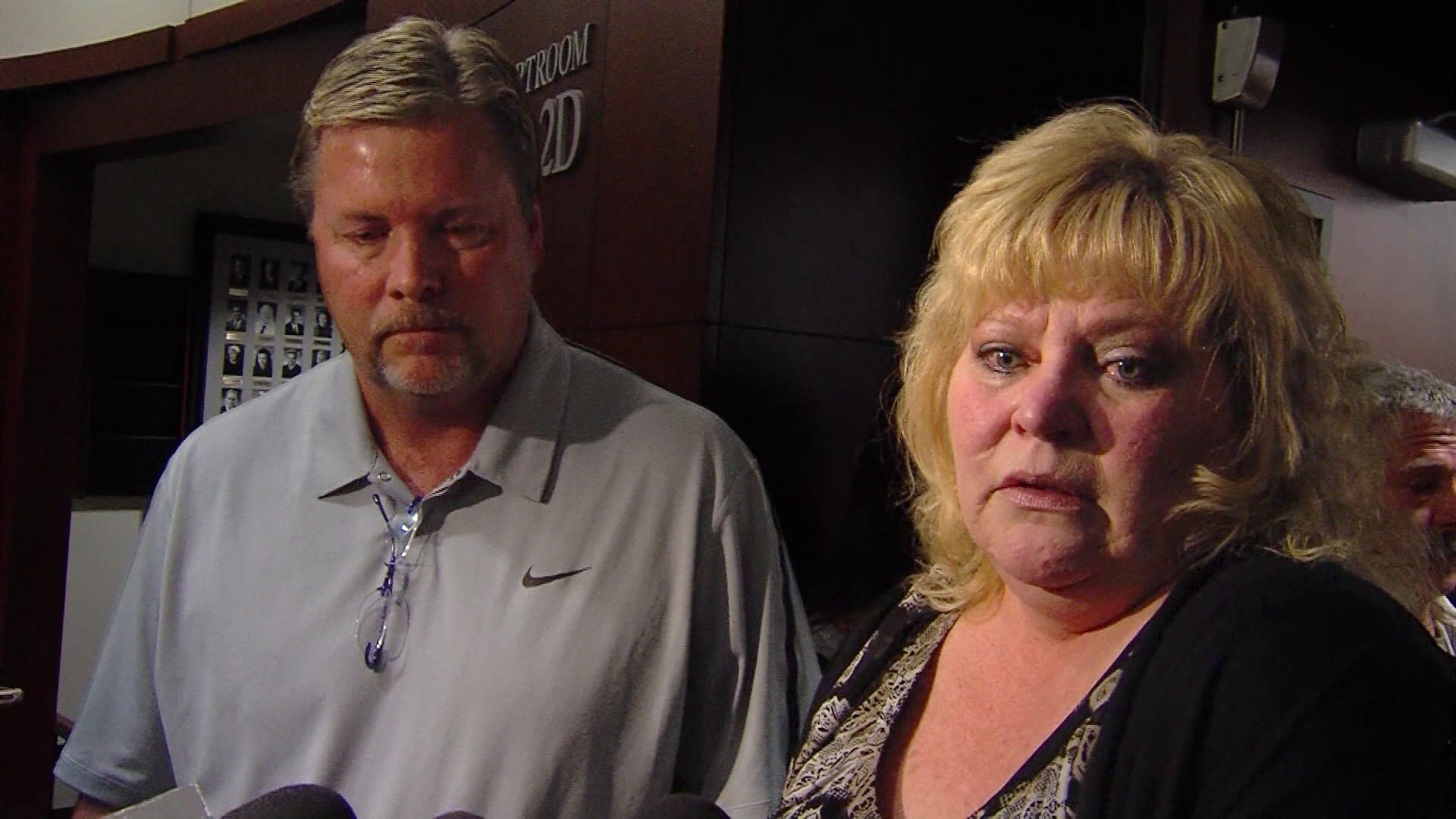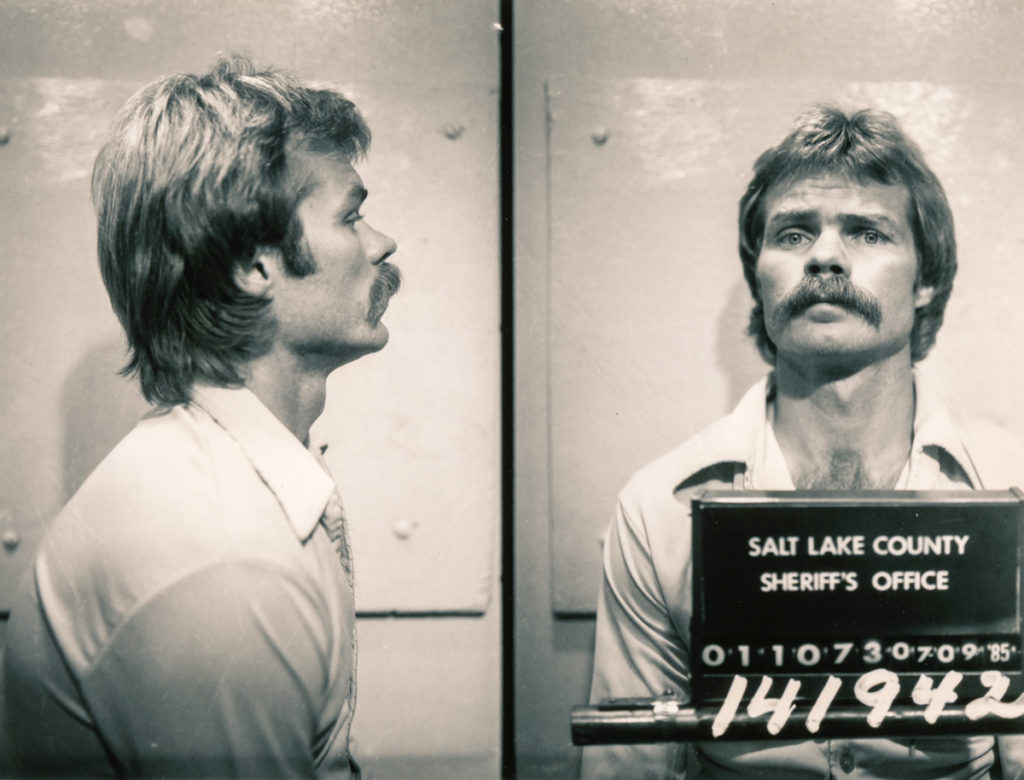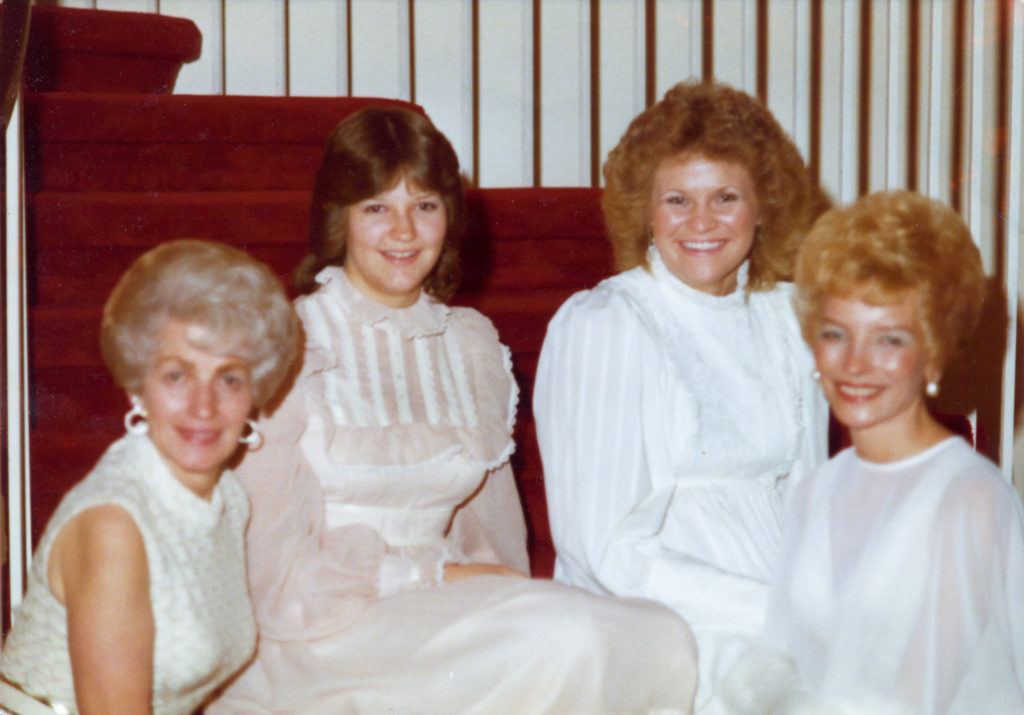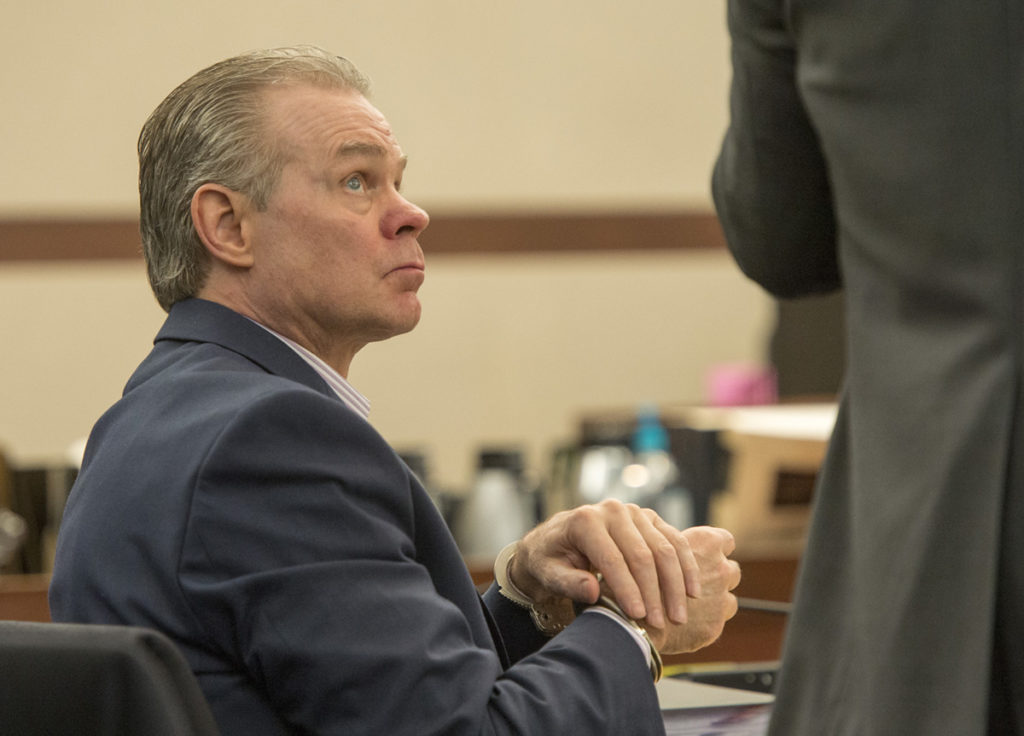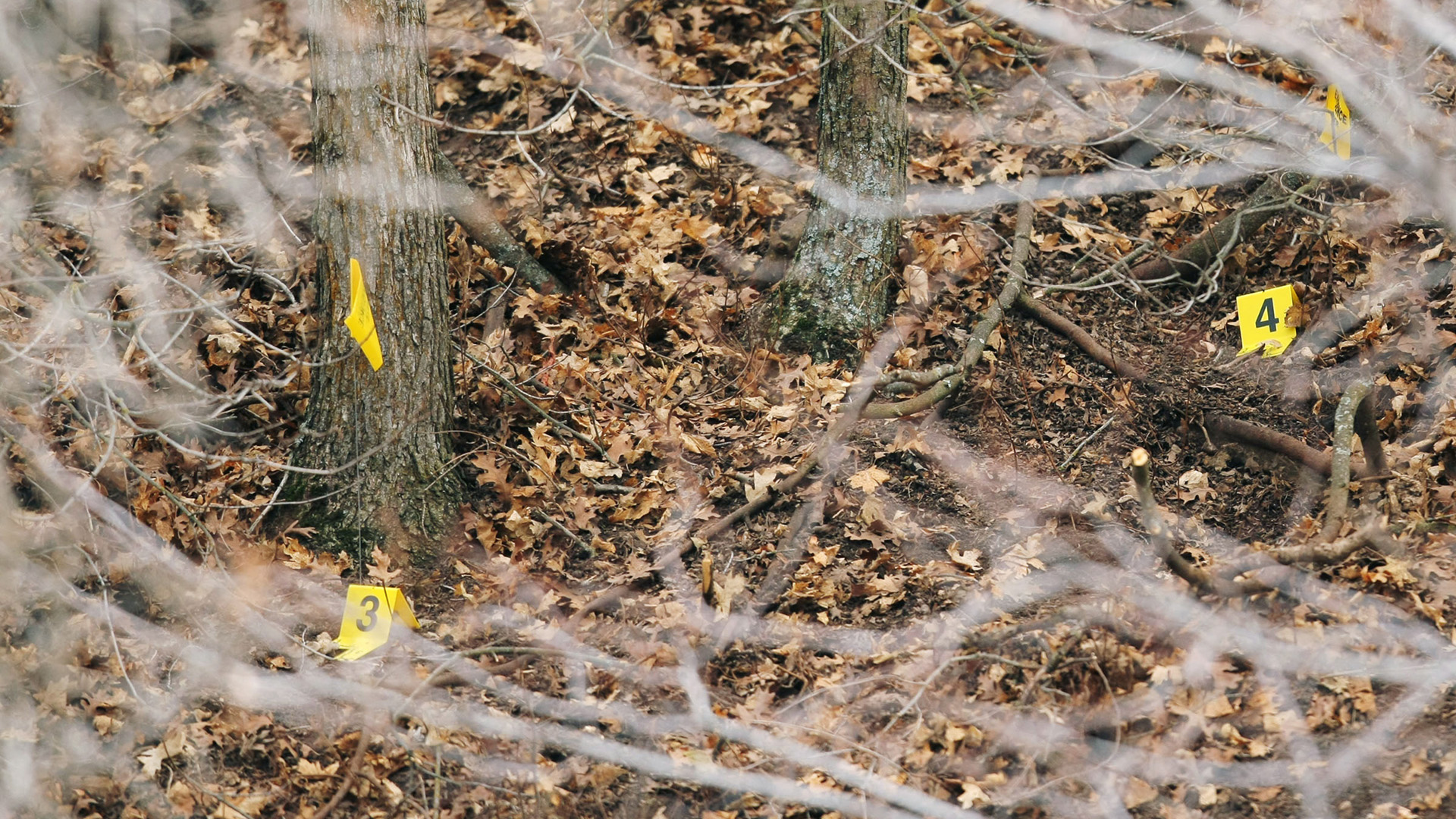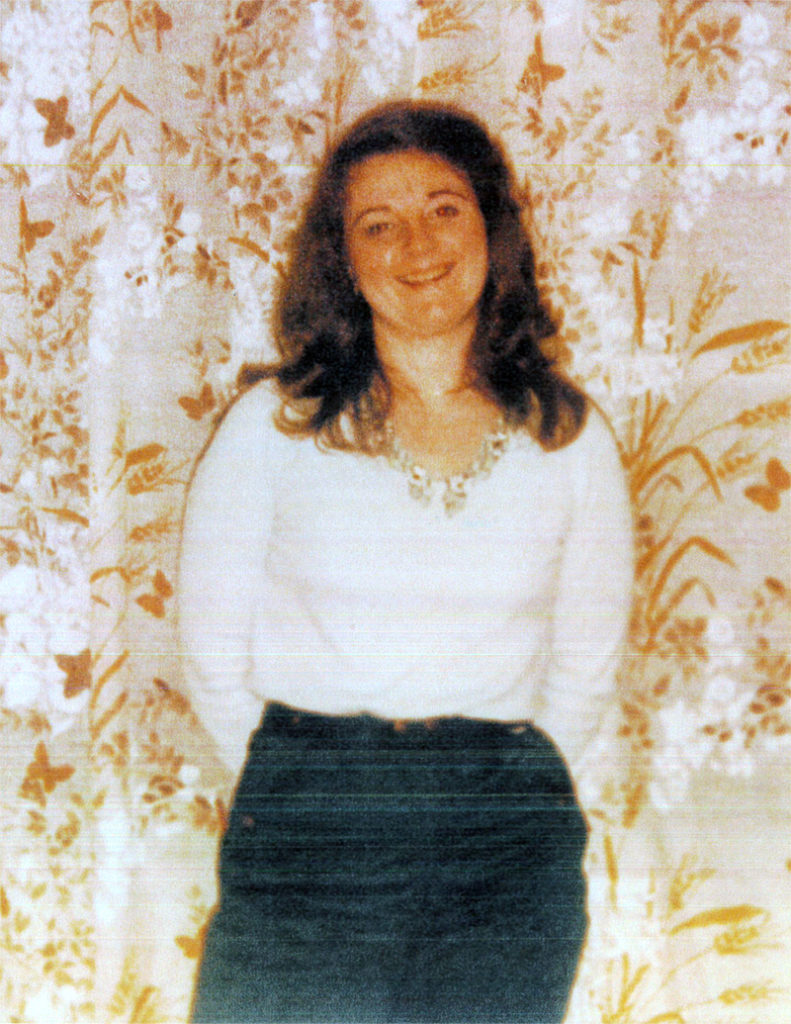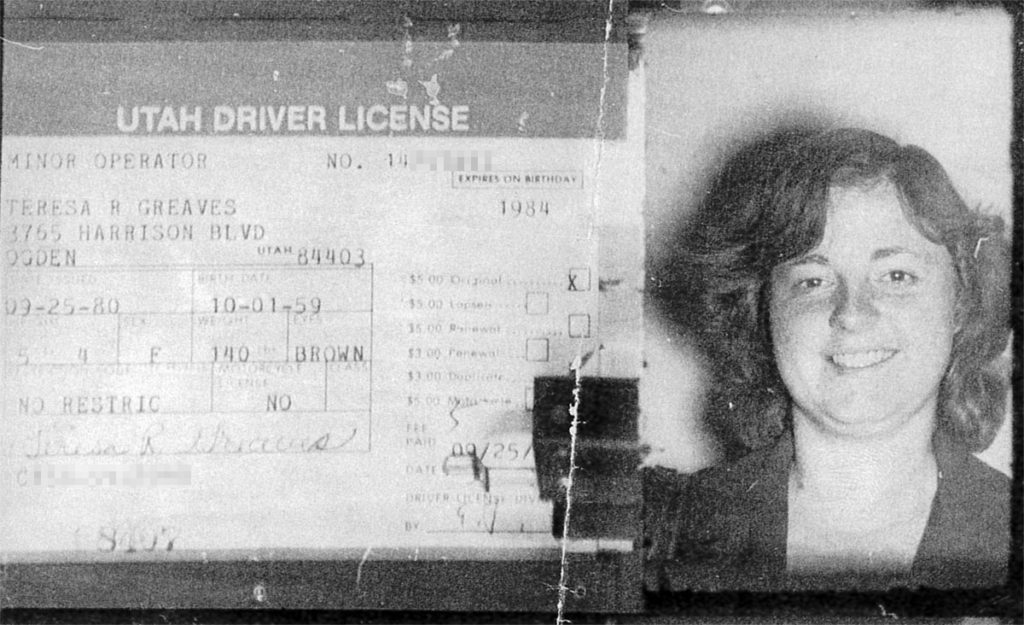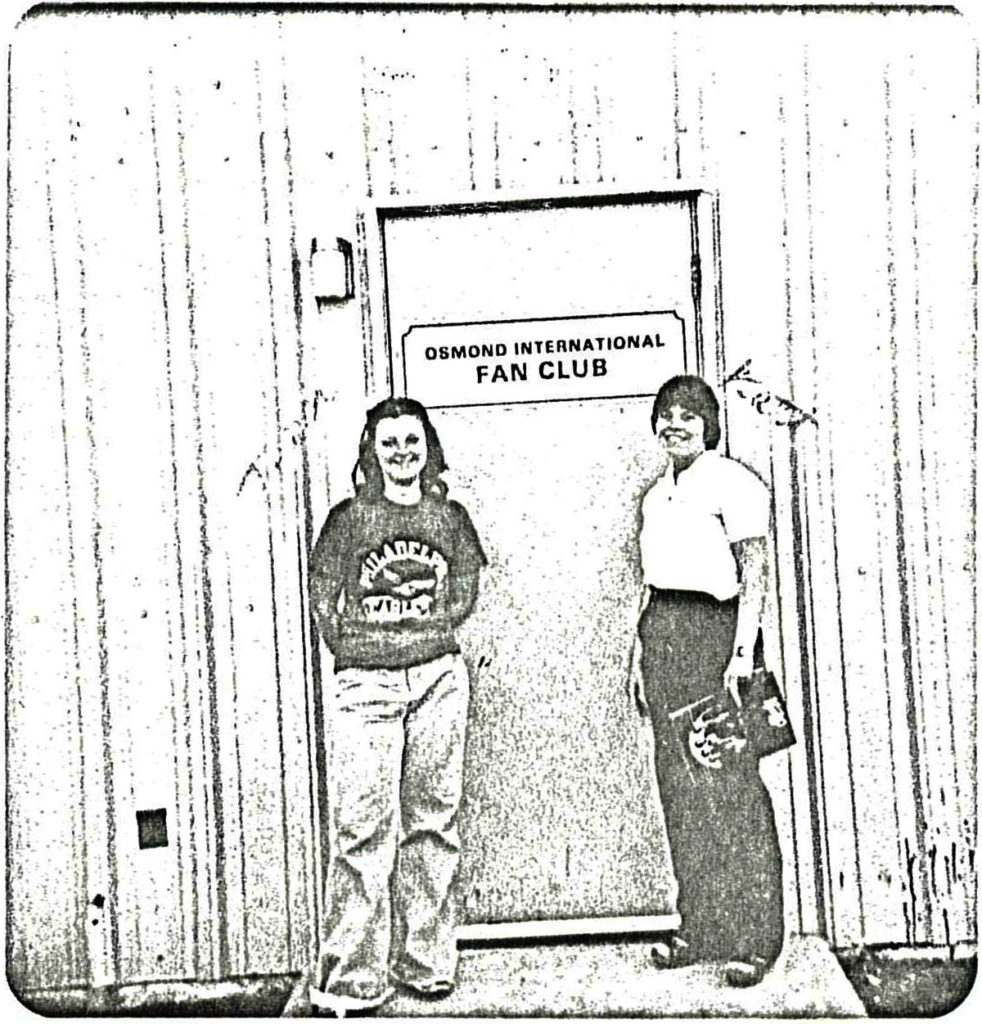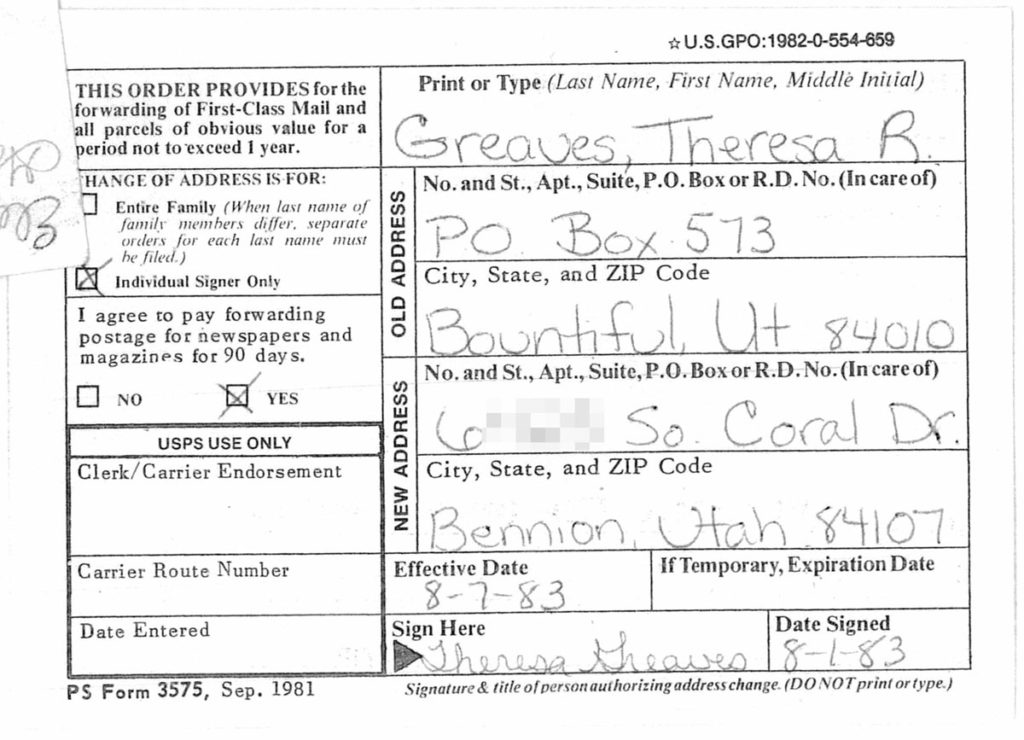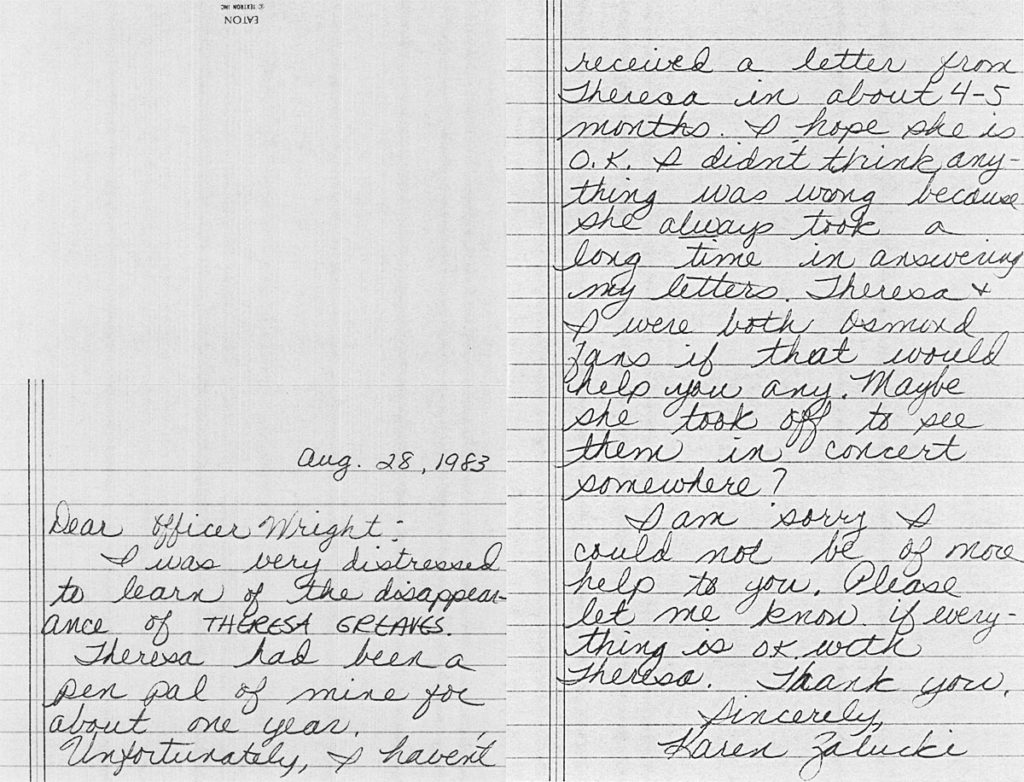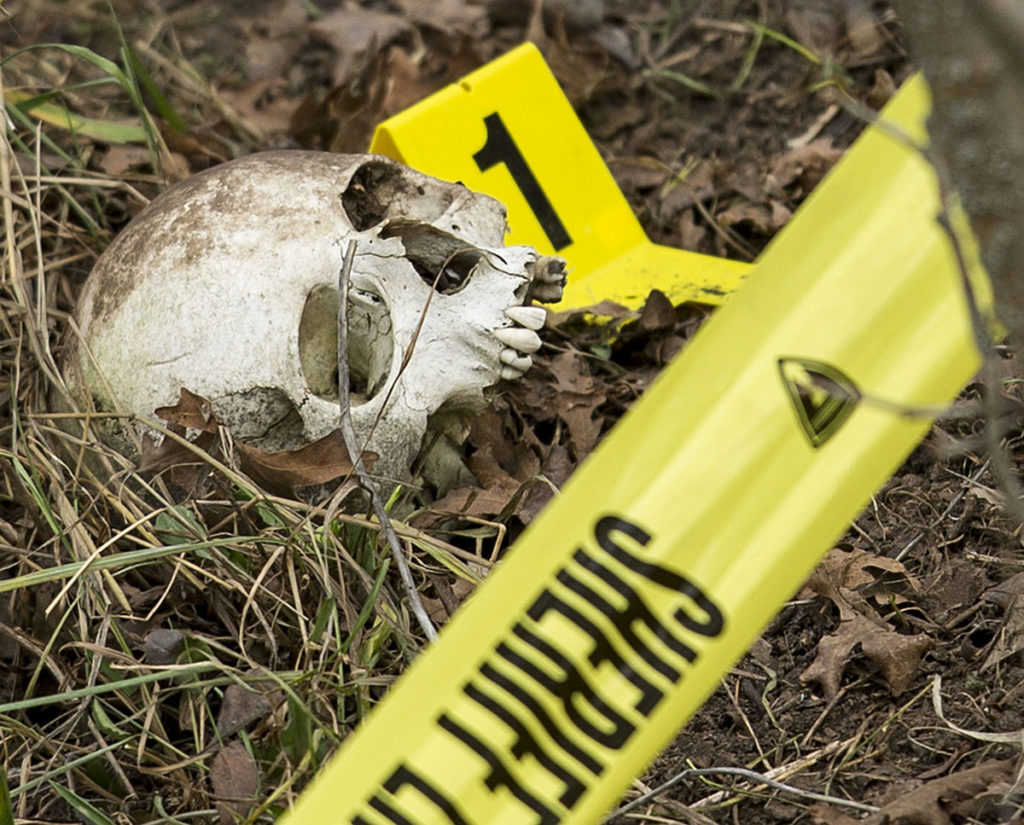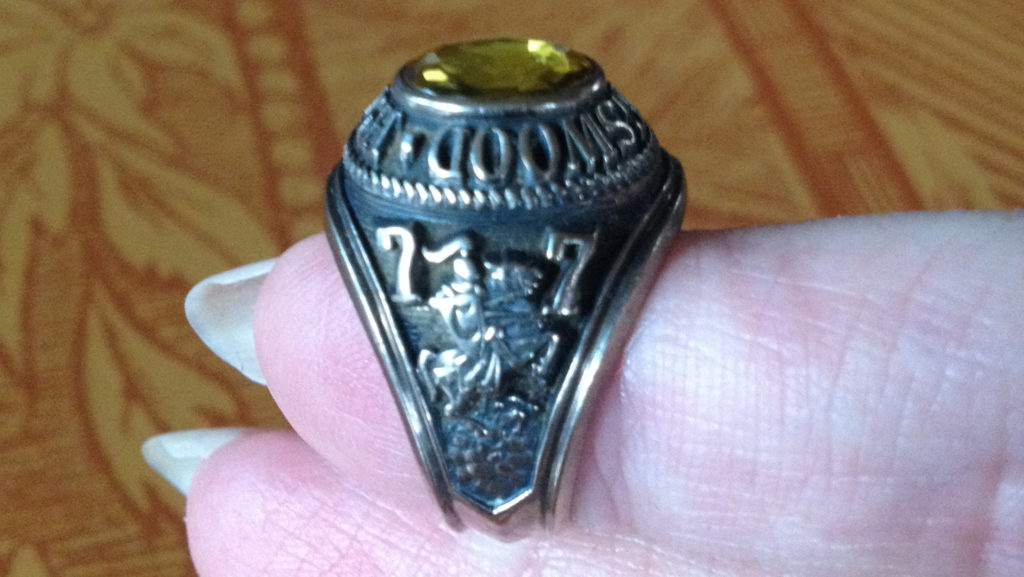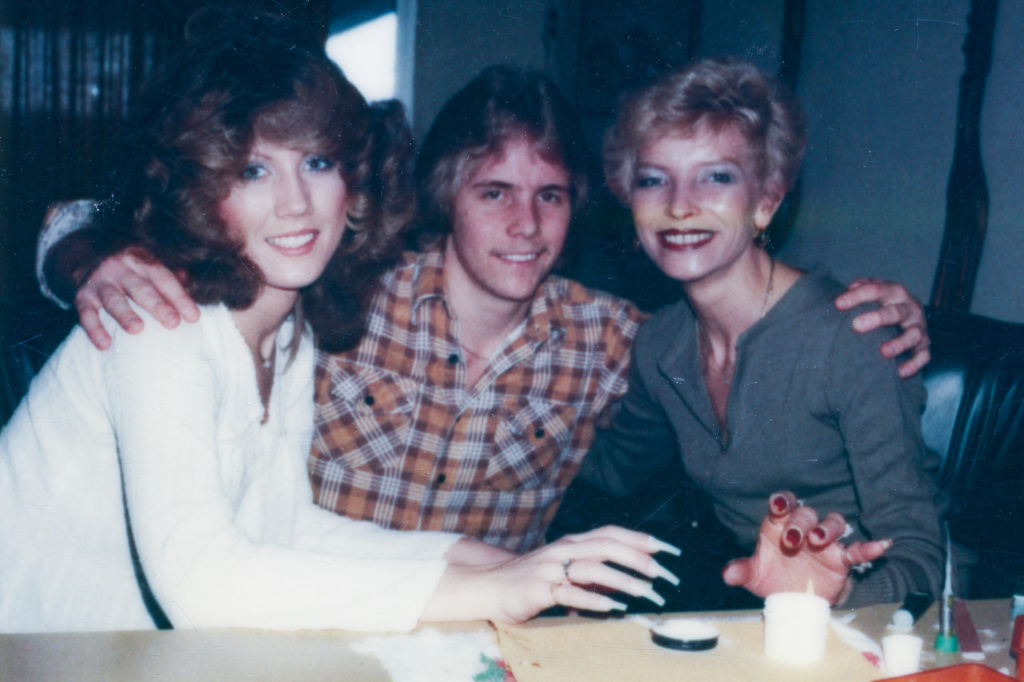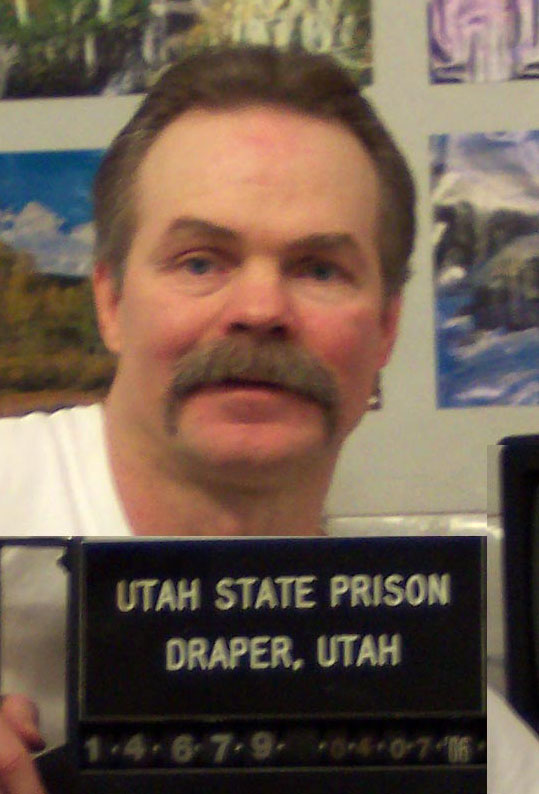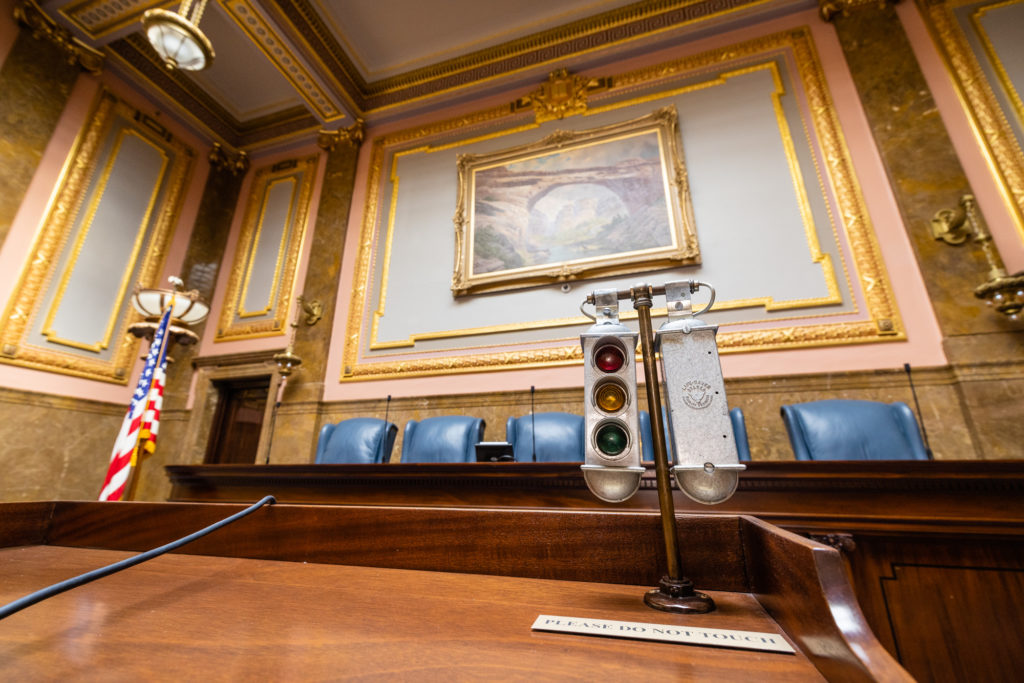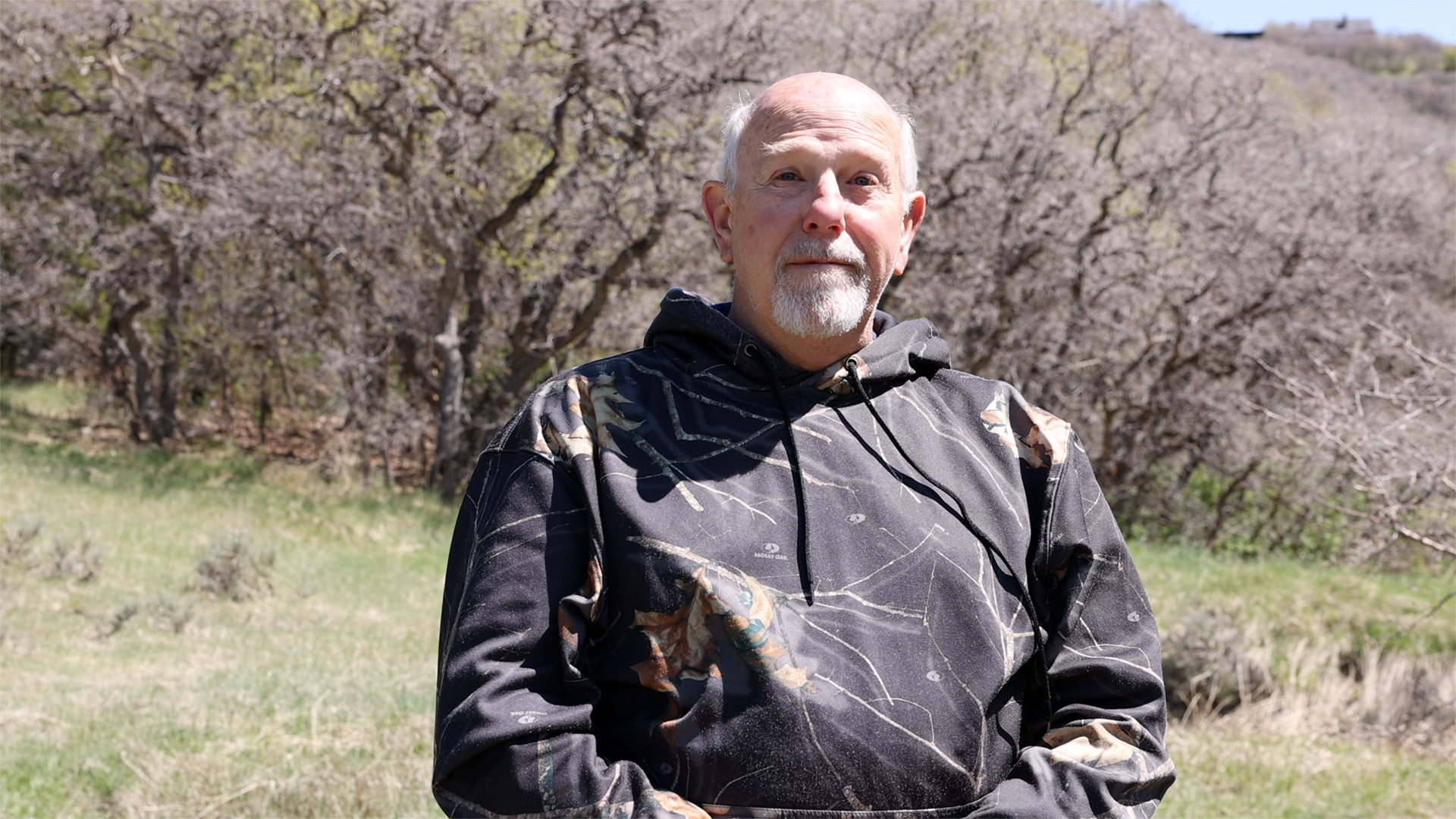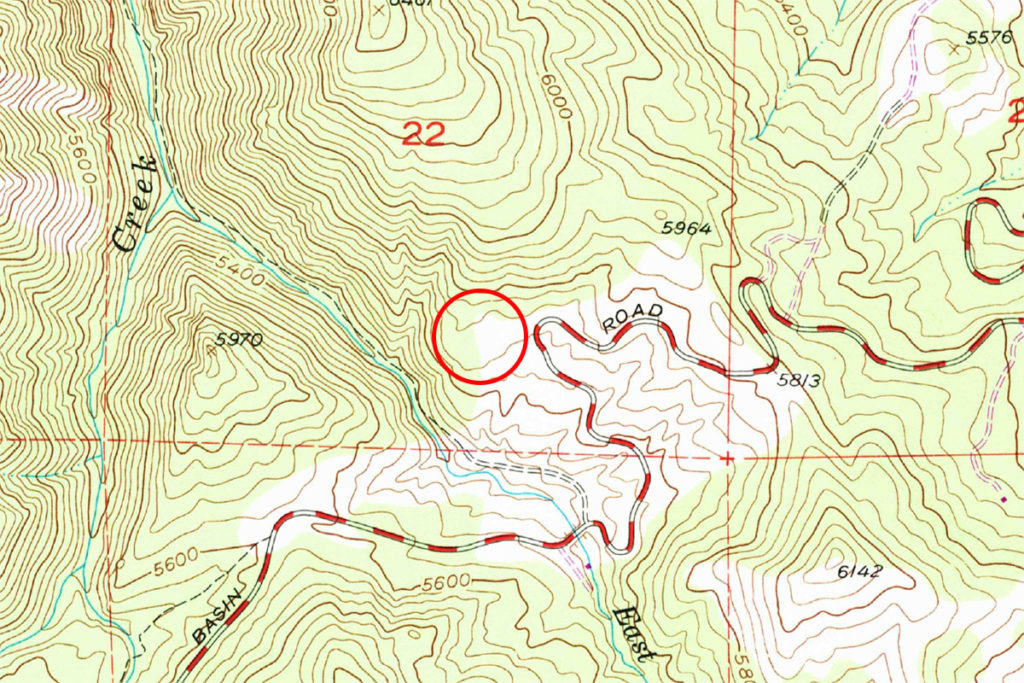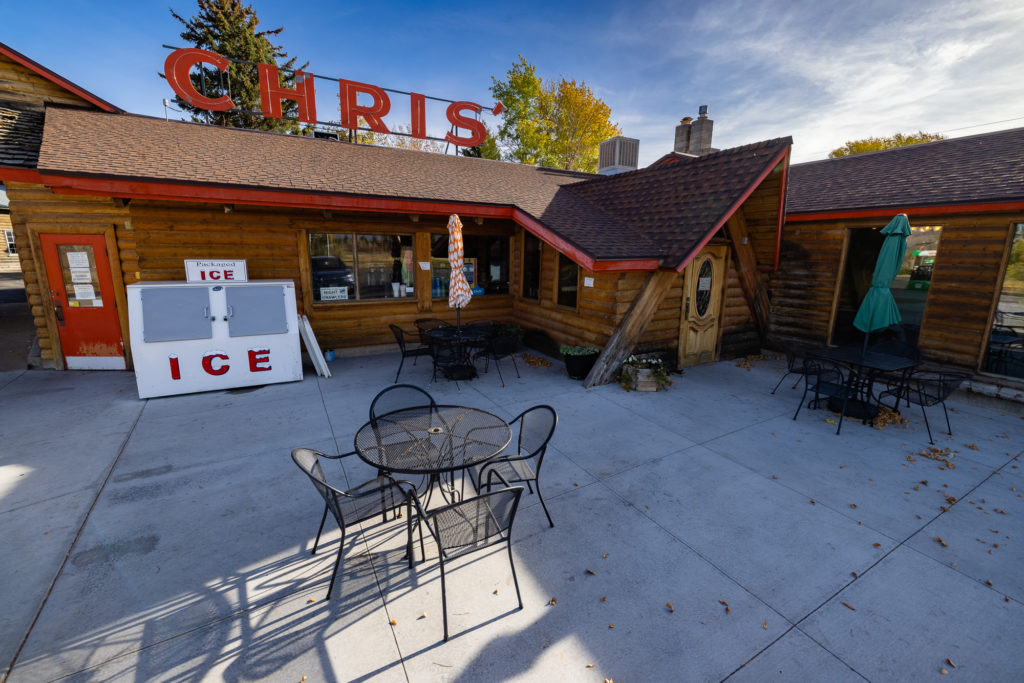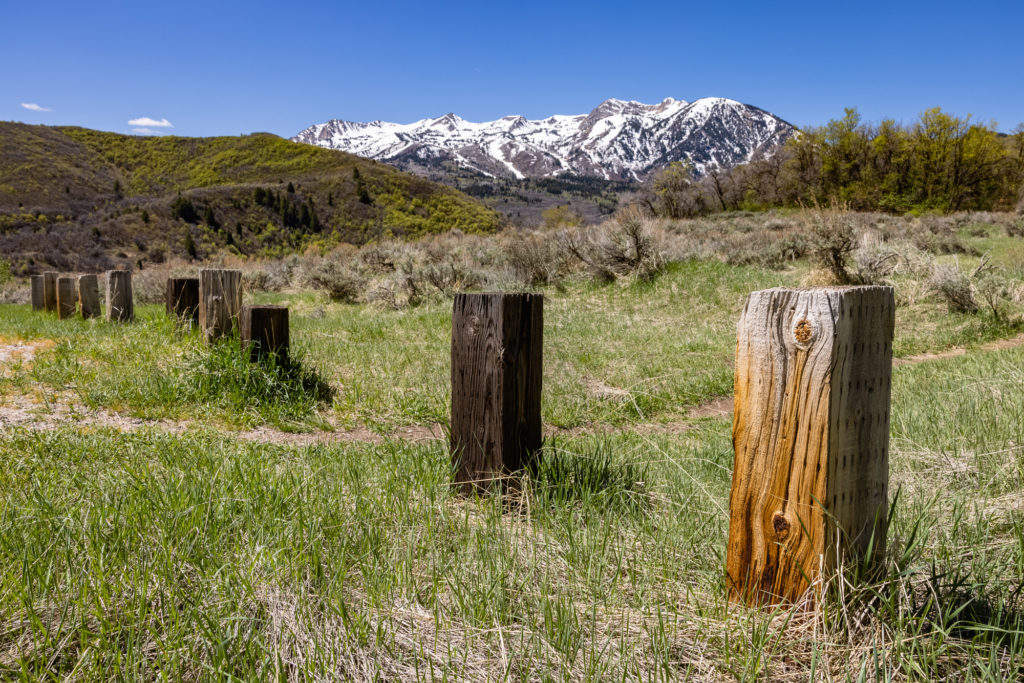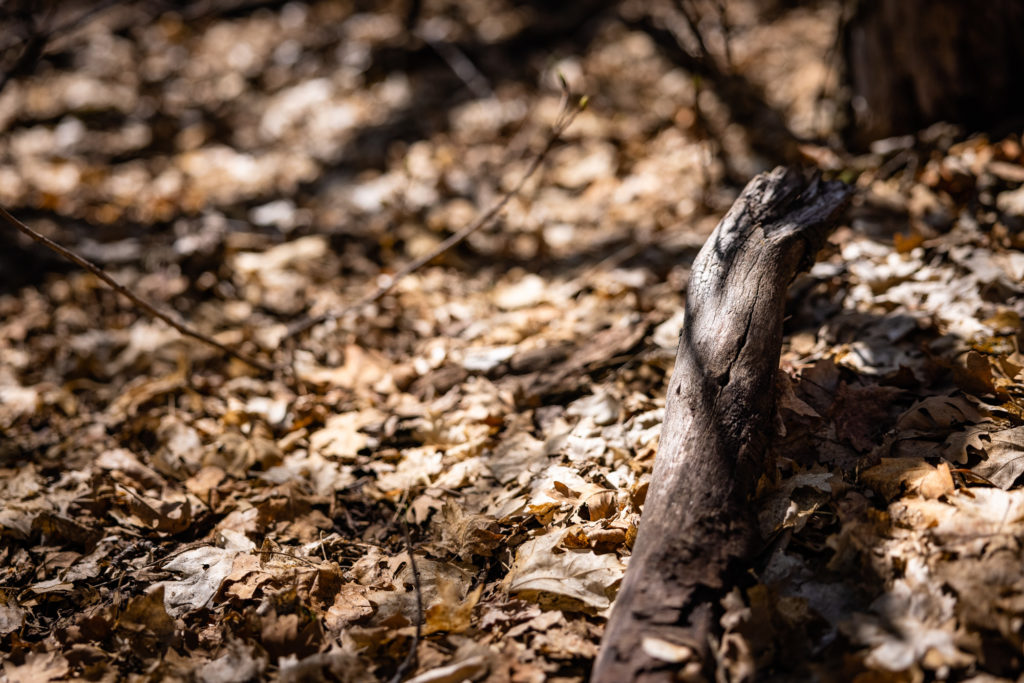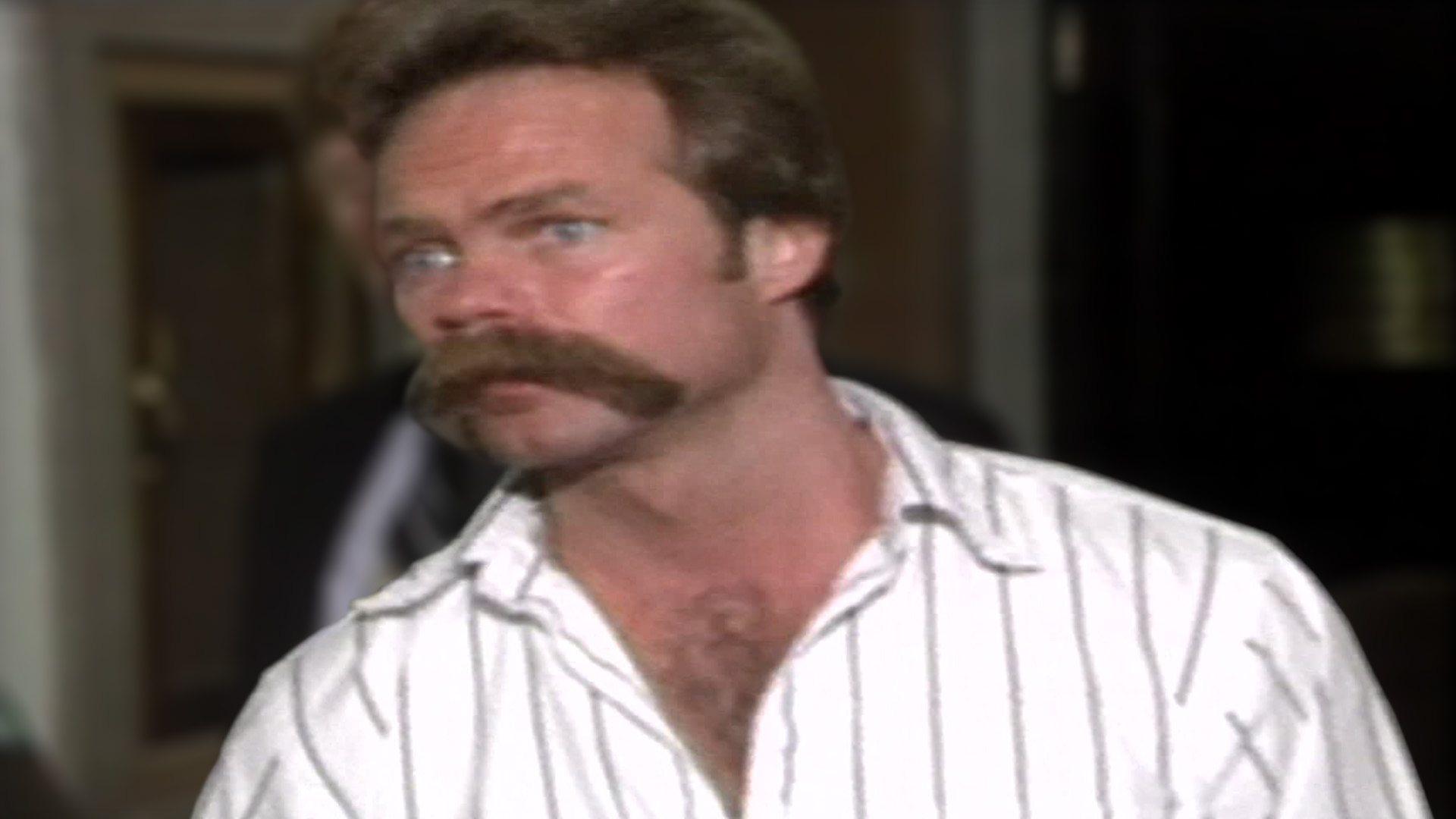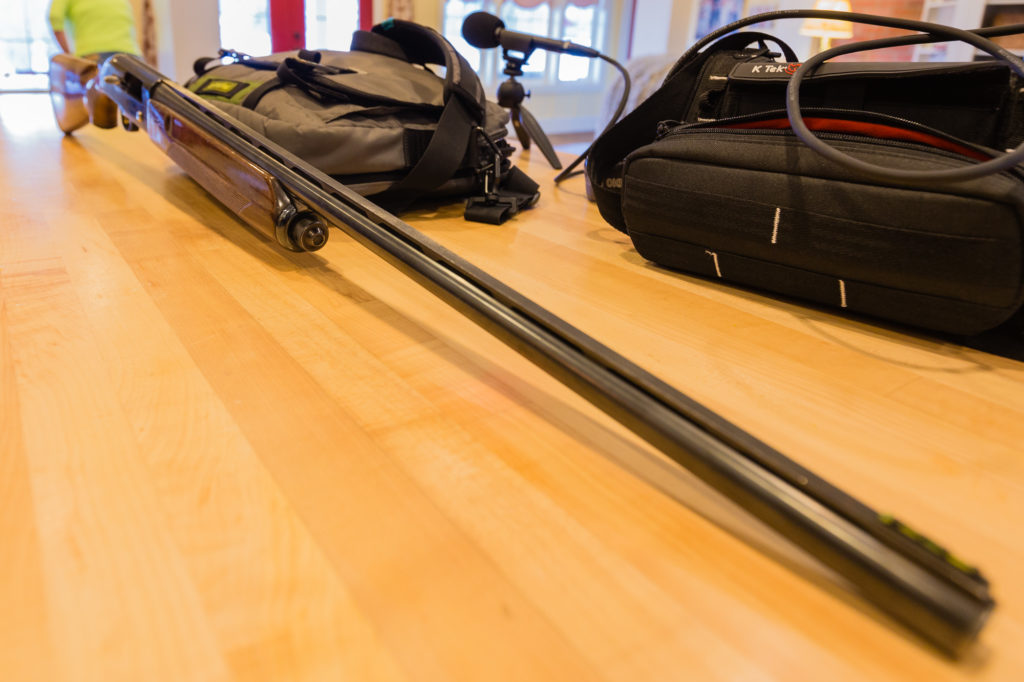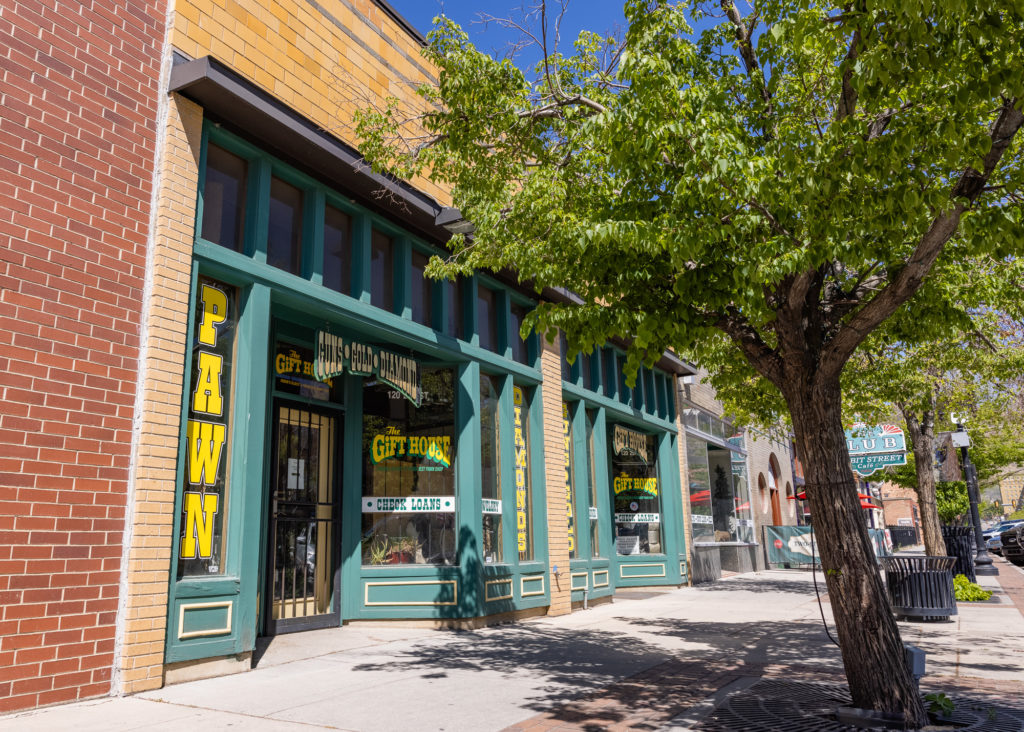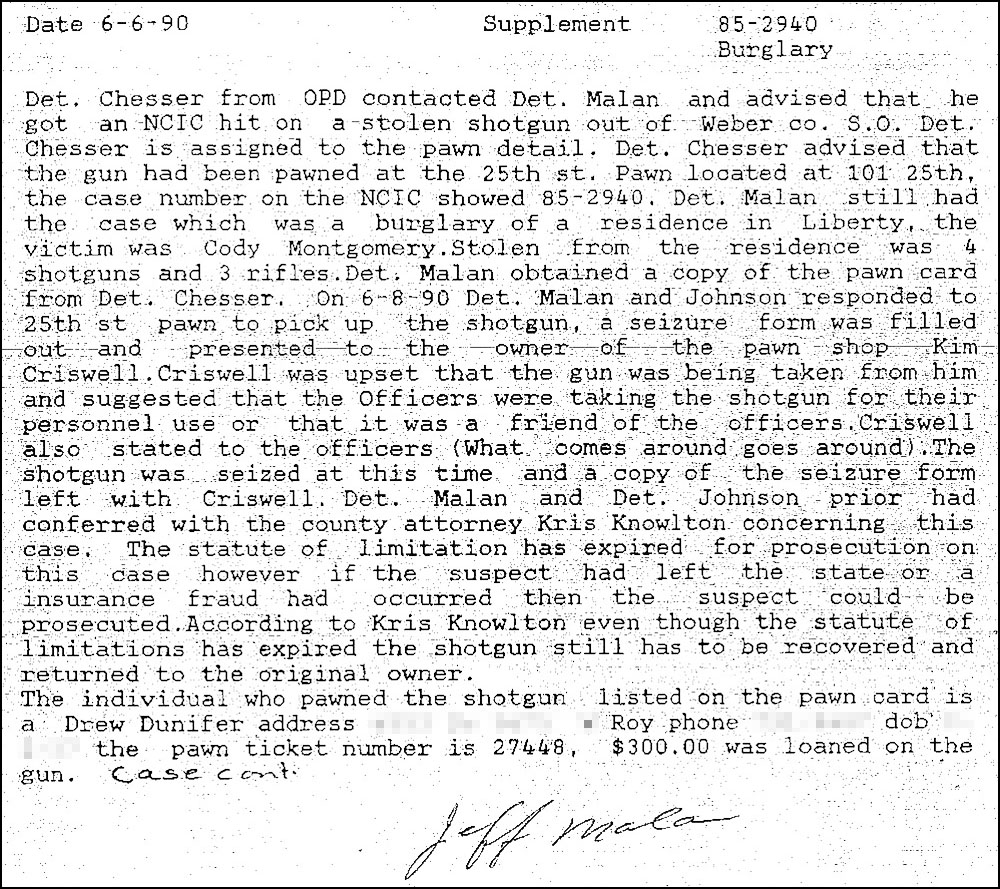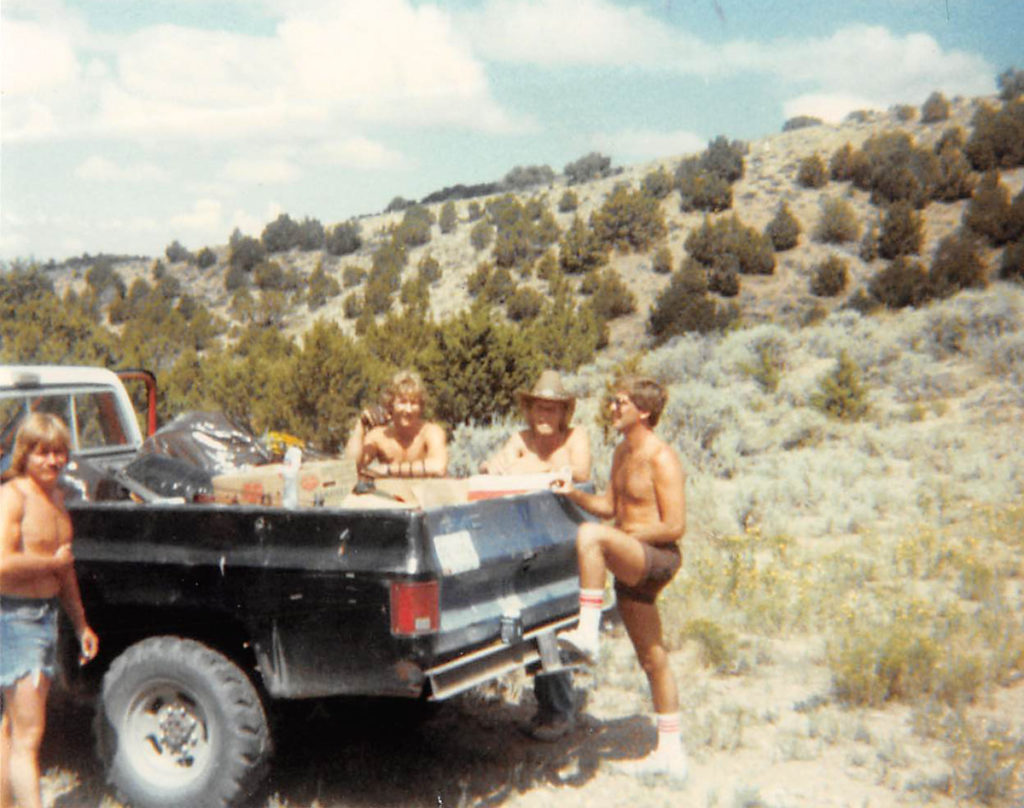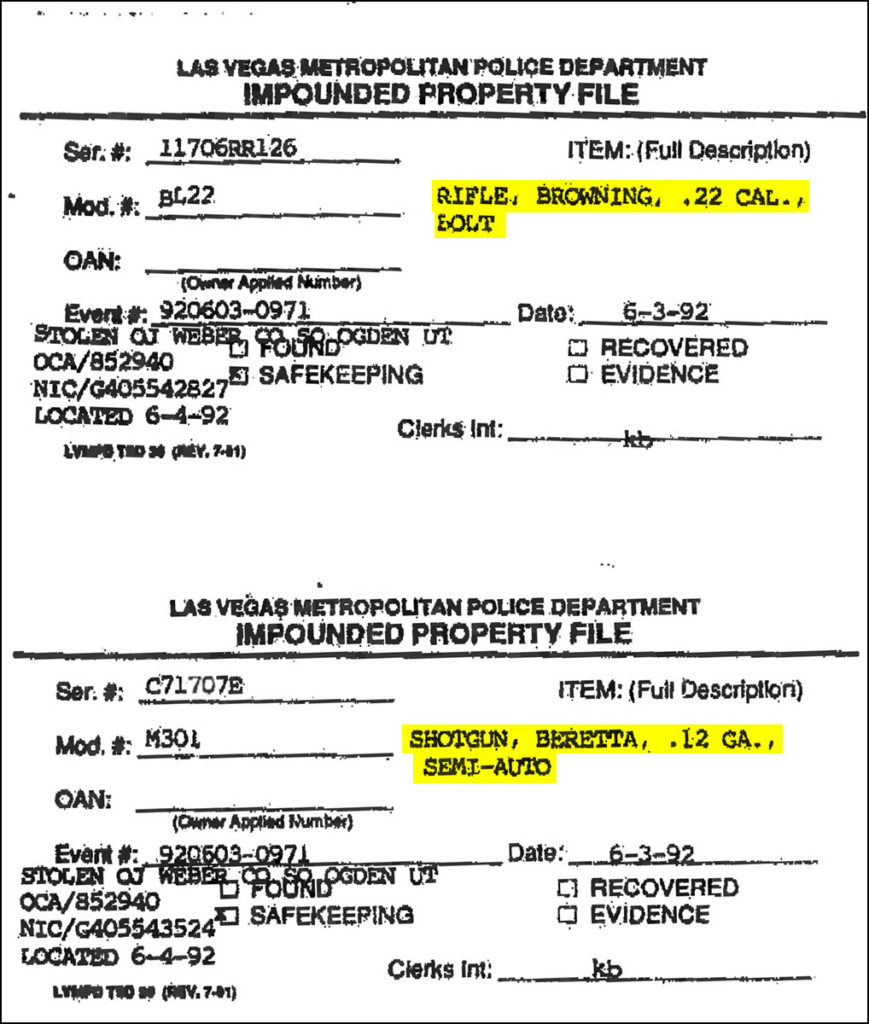Dave Cawley: The penalty phase of Doug Lovell’s trial for the murder of Joyce Yost began on March 20, 2015.
Mike Anderson (from March ??, 2015 KSL TV archive): Prosecutors described in detail Douglas Lovell’s rape and murder of Joyce Yost back in 1985 and a long criminal history that started in his teen years.
Dave Cawley: Kim Salazar and Greg Roberts had each testified already, during the trial’s guilt phase. But they took the stand again in the penalty phase and were able to tell a broader story.
Greg Roberts: It was great to look at the jury and just tell our side and I mean I think it had an impact.
Dave Cawley: This was an opportunity Kim and Greg had not had during Doug’s original sentencing in ’93. They were able to tell the jurors who their mother was…
Greg Roberts: She was a great, great, great, mother. She was just a wonderful grandmother. She was so happy.
Kim Salazar: Everybody will say the same thing. ‘Oh, she was so beautiful. Oh, she was so sweet. She was the kindest woman, she,’ and she was. She was genuine.
Dave Cawley: …and they described the far-reaching — and ongoing — impacts of what Doug had done to her.
Kim Salazar: I don’t know, he’s a horrible person and he’s done horrible things. And he’s, as far as I’m concerned he’s continued to do horrible things to our family for all these years.
Dave Cawley: Kim’s children, who were by then adults, sat in the gallery as she testified. Their dad, Kim’s ex-husband Randy, was right beside them.
Randy Salazar: When Kim testified this last time … she said she wanted to apologize to her ex-husband for not being the wife she could have been and she also apologized to her kids for not being 100-percent focused on them when she should have. But you know, I mean, there was no. She, she did nothing wrong.
Greg Roberts: Yeah I think Kim’s oldest Melisa and, y’know, Melisa and Melanie, her children have a lot of resentment on what this has done to their mom’s whole life. Of where it’s become the main focus of your life.
Dave Cawley: Kim and Randy’s daughters even took the stand themselves, to describe how their young lives had changed when their grandma Joyce had disappeared.
Randy Salazar: And now my kids are older. Now they have to listen to this. And Kim and Greg, we got to go through this whole trial again. (Pause) Not fair. Not fair.
Dave Cawley: Greg’s children had not even been born at the time of Joyce’s murder.
Greg Roberts: I miss terribly that my kids couldn’t know her and get a bigger piece of her, uh, growing up. A bigger influence from her growing up.
Kim Salazar: He took all that from us.
Greg Roberts: That’s part of my biggest regrets.
Dave Cawley: This is Cold: season 2, episode 12: Dancing with the Devil. From KSL Podcasts, I’m Dave Cawley. We’ll be right back.
[Ad break]
Dave Cawley: The Weber County Attorney’s Office pushed for a sentence of death against Doug Lovell during the penalty phase of his 2015 capital murder trial. They had a proxy once again read a transcript of Doug’s own words from the earlier ’93 sentencing hearing. They played portions of the two wire recordings with Doug and Rhonda inside the Utah State Prison, focusing on portions like this one, where he’d talked about the anonymous caller who’d reported finding a body near Causey Reservoir.
Doug Lovell (from January 18, 1992 wire recording): The only thing I’m nervous about is that one time that caller called in. I remember, ah, seeing it on TV.
Dave Cawley: And they put an investigator on the stand to tell the jury how those remains had never been located or recovered. Then, it was Doug’s turn. His defense team — lawyers Michael Bouwhuis and Sean Young — made their case for a sentence of life with the possibility of parole.
The first three defense witnesses were John Newton, Gary Webster and Chuck Thompson. All three men had at various times served as bishops for The Church of Jesus Christ of Latter-day Saints at the Utah State Prison. All had ministered to Doug.
Defense attorney Sean Young led the questioning of the bishops and the results were, I’ll just say, stilted. Apologies in advance for the poor quality of this audio, it’s unfortunately the best available for this piece of testimony.
Sean Young (from March 23, 2015 court recording): And are you aware of Mr. Lovell’s current status with the Latter-day Saint church?
Chuck Thompson (from March 23, 2015 court recording): Yes I am.
Sean Young (from March 23, 2015 court recording): And what is that?
Chuck Thompson (from March 23, 2015 court recording): He’s excommunicated.
Dave Cawley: If you couldn’t make that out, Chuck Thompson acknowledged that Doug had been excommunicated from The Church.
Chuck’s testimony wasn’t exactly a ringing endorsement for Doug, but that wasn’t because Chuck held reservations about Doug’s character. To the contrary. He very much believed Doug was a reformed man. So why didn’t he emphatically express that belief?
There’s a back story to these bishops that requires some explanation. Doug had identified four bishops, as well as the person above them in the church’s hierarchy — called a stake president — on his witness list.
Prior to the trial, attorneys from the law firm Kirton McConkie — acting as outside counsel to The Church — had connected with these five men to offer them legal representation if they wanted it. The church’s attorneys had advised the bishops they were not permitted to speak on behalf of the church, or about matters of doctrine or policy. But John Newton, Brent Scharman, Gary Webster and Chuck Thompson had all wanted to speak for Doug. They all believed him worthy of a chance for parole.
The Church of Jesus Christ, unlike many other Christian faiths, does not take a public position on the issue of capital punishment. The church’s lawyers communicated to Doug’s defense team that, in their view, putting all the bishops and their stake president on the stand on Doug’s behalf might lead some people to assume — incorrectly — that The Church was taking an official position on his specific case. The church’s lawyers advised Doug’s defense if they wanted to question the bishops, they would have to compel that testimony by subpoena.
Defense attorneys Michael Bouwhuis and Sean Young reached a compromise. They would subpoena just three of the bishops and in exchange the church’s lawyers agreed not to fight those subpoenas.
Sean Young (from March 23, 2015 court recording): And just for the record, you’re here under order of subpoena today. Is that correct?
Chuck Thompson (from March 23, 2015 court recording): It is. I’m under order of subpoena.
Sean Young (from March 23, 2015 court recording): Ok, no further questions at this time, your honor.
Dave Cawley: When these three bishops testified at the trial, they each made mention of Doug’s charitable giving to Rising Star Outreach. Becky Douglas, the head of that non-profit, arrived at the Weber County Courthouse the following morning. She’d traveled all the way from the Dominican Republic, where her husband was at that time serving as a mission president for The Church. Becky, in her role as “companion” to the mission president, had needed Church permission to leave that post, even temporarily. That permission had been slow in coming, and Becky had at one point told a supervisor they were welcome to excommunicate her, but she would testify on Doug’s behalf no matter what.
In a later court hearing, Becky would describe encountering a church lawyer at the courthouse on the day she’d arrived to testify.
Becky Douglas (from August 12, 2019 court recording): A man approached me and said ‘Are you Becky Douglas?’ I said ‘Yes.’ He said ‘Could I have a word with you?’
Dave Cawley: Becky said she’d told the man she intended to tell the truth, the whole truth and nothing but the truth, which he agreed she should do. They’d both then entered the courtroom and sat in the gallery.
Becky Douglas (from August 12, 2019 court recording): When I was called to testify I got up. He stood up so I could get out and he put his hand on my arm and he said, gave me a pat and he said ‘I’m sure you’ll do just fine.’ That actually felt a little intimidating to me.
Dave Cawley: I wanted to ask Becky about this, but she didn’t respond to an interview request for this podcast. But consider, it’s not surprising or even unexpected a lawyer for an organization that’s being discussed in court might want to be present to hear that testimony firsthand. I’ll go into more detail about whether or not this amounted to intimidation or interference in the next episode.
In Becky’s testimony, she voiced the most emphatic support for Doug of all his character witnesses, portraying him as a giving, caring man who in spite of past failures had endeavored to become a better person.
The next day, she received an email from one of Doug’s bishops, Chuck Thompson. Here’s what it read:
Scott Mitchell (as Chuck Thompson): Hello Becky, nice job on the testimony. You hit the nail on the head. I was careful to say too much with my church position. In fact, I was instructed to say as little opinion as I could and followed counsel.
Dave Cawley: Becky replied to this email, describing her own discomfort over the presence of the church’s lawyers at the trial.
Amy Donaldson (as Becky Douglas): But I felt very blessed. I had prayed for the spirit and as I took the stand I felt a calm peace settle over me. It seemed that whenever the prosecuting attorney closed some doors they were later opened by the Lord in unexpected manners and I was able to share the things I had come to share.
[Scene transition]
Dave Cawley: Becky Douglas and Doug’s bishops constituted just a fraction of the people on the defense’s witness list. But many of the others didn’t show up to testify. Defense attorney Sean Young told Judge Michael DiReda their mitigation specialist had struggled to locate some of these people.
I want to look at one of those in particular. His name was Brian Peterson. Brian had worked as a prison guard at SSD. During Doug’s first sentencing for the murder in ’93, Brian had told the story of the time Doug had washed the eyes of another guard who’d been accidentally been sprayed with insecticide.
Sean told Judge DiReda no one could find Brian. The defense had mailed a subpoena to what they believed was his address, but he hadn’t showed up as ordered. Sean asked the judge to declare Brian unavailable, which would allow the defense to simply present his testimony from transcript. Judge DiReda said this troubled him.
Michael DiReda (from March ??, 2015 court recording): I guess I’m troubled by the fact that no one has physically gone to the address to confirm that this person in fact is there or not there.
Dave Cawley: In the absence of these other character witnesses, the defense turned to its experts. They brought forward not one but two Ph.D-level forensic psychologists.
Michael Bouwhuis (from March 31, 2015 KSL TV archive): Somewhere between the age of six and eight, one of his brothers hit him in the head with a rock.
Mike Anderson (from March 31, 2015 KSL TV archive): Lovell’s attorneys described how he had a long history of head trauma, including a major construction accident as an adult.
Dave Cawley: One of the psychologists, Mark Cunningham, spent hours on the stand talking about Doug’s youth and the environment in which he’d been raised.
Michael Bouwhuis (from March 31, 2015 KSL TV archive): After the divorce came everything else, all these crimes that you’ve heard about.
Mike Anderson (from March 31, 2015 KSL TV archive): Then there was the troubled childhood. His mom’s struggle with depression.
Dave Cawley: Cunningham placed blame on Doug’s parents, saying his mother Shirley had been distant and detached. She’d been so medicated, he said, that she hadn’t nurtured her youngest son. Cunningham said Doug’s father Monan had been absent or worse, outright abusive to Doug’s mother Shirley. As a result, he said, Doug had modeled that behavior as he’d grown into a man.
There may’ve been some truth in one or both of these claims. The problem was, there weren’t any other defense witnesses with first-hand knowledge of Doug’s childhood who backed up what Cunningham said. Doug himself had, in many of his letters, described having a wonderful childhood with loving parents.
There’s one other expert witness Doug’s defense called to testify. His name was David Stoner.
David was a wildlife biologist and Ph.D-level ecologist at Utah State University. He was an expert on the topic of mountain lions. The purpose of his testimony was to provide an explanation for why Joyce’s body hadn’t been at the spot along the Old Snowbasin Road where police had searched in ’93.
David Stoner (from March 30, 2015 court recording): It’s been acknowledged by a number of authorities that animals tampering with human bodies really confounds these investigations.
Dave Cawley: The defense used this to suggest Doug had acted in good faith, that he’d made an honest attempt to lead the searchers to Joyce’s body. Prosecutor Gary Heward attacked this idea on cross-examination. Even if animals had scattered the remains, Gary asked where were Joyce’s clothes? Her necklace? Her purse?
Gary Heward (from March 30, 2015 court recording): It’s also true, isn’t it Dr. Stoner, that animals are not going to have any interest in a woman’s purse?
David Stoner (from March 30, 2015 court recording): I wouldn’t think so.
Gary Heward (from March 30, 2015 court recording): The jewelry she’s wearing, the contents of her purse?
Dave Cawley: And though it didn’t come up in court, I’ll suggest you to consider what had happened to Theresa Greaves. When police had located her remains on that hillside just a month before this trial, they’d also found animals bones and droppings in the area. Yet, in more than 30 years, scavengers had not dug up Theresa’s remains.
Defense attorney Michael Bouwhuis next put Rhonda back on the stand. Michael showed old family pictures of Doug, Rhonda and her daughter Alisha together on camping trips. He talked about how Doug had wanted to adopt Alisha. Then, he had Rhonda read portions of the loving letters she’d written to her husband after he went to prison for raping Joyce.
Rhonda Buttars (from March 30, 2015 court recording): It’s just not the same with you not with us. Doug, I love you with all my heart and soul and I never want us to be apart from each other. I would die without you, Doug. Us and the kids are one and we can never break that.
Dave Cawley: Michael’s questioning of Rhonda painted them as a happy family, with Doug a dedicated father. On cross, prosecutor Gary Heward drew a different picture of Rhonda…
Gary Heward (from March 30, 2015 court recording): Are you afraid of Doug Lovell?
Rhonda Buttars (from March 30, 2015 court recording): Yes I am.
Dave Cawley: …as a woman long plagued by conscience…
Gary Heward (from March 30, 2015 court recording): Rhonda, how did it make you feel when you, in 1991, told Terry Carpenter what’d happened to Joyce? How did it make you feel?
Rhonda Buttars (from March 30, 2015 court recording): I was very relieved.
Gary Heward (from March 30, 2015 court recording): Did defendant Douglass Lovell ever show you or take you to where he had dumped the body of Joyce Yost?
Rhonda Buttars (from March 30, 2015 court recording): No.
Gary Heward (from March 30, 2015 court recording): Did he ever tell you where he had dumped the body of Joyce Yost?
Rhonda Buttars (from March 30, 2015 court recording): Just up by Causey.
Gary Heward (from March 30, 2015 court recording): Is that the only thing he ever told you? Up by Causey?
Rhonda Buttars (from March 30, 2015 court recording): Yes.
Gary Heward (from March 30, 2015 court recording): He never told you on Snowbasin Road?
Rhonda Buttars (from March 30, 2015 court recording): No.
Gary Heward (from March 30, 2015 court recording): Never used those words?
Rhonda Buttars (from March 30, 2015 court recording): Not to me.
Dave Cawley: Rhonda dropped something of a bombshell toward the end of her time on the stand, regarding one time when she’d visited Doug at the prison in the late ‘80s.
Rhonda Buttars (from March 30, 2015 court recording): Yes, on one visit, umm, he said if he had to do a really long time in there, that he would plan an escape.
Gary Heward (from March 30, 2015 court recording): Those were his words?
Rhonda Buttars (from March 30, 2015 court recording): And I said — yes — I said ‘where would you go?’ And he said ‘up in the mountains.’
Dave Cawley: Rhonda had never said anything about this until a couple of weeks prior, when she’d revealed it to the prosecution.
Michael Bouwhuis (from March 30, 2015 court recording): And so, the times that you’ve testified previously in this case under oath, you did not, in fact, mention anything about an escape plan, did you?
Rhonda Buttars (from March 30, 2015 court recording): Nope.
Michael Bouwhuis (from March 30, 2015 court recording): Did not. Until today.
Rhonda Buttars (from March 30, 2015 court recording): Yep.
Dave Cawley: Which led defense attorney Michael Bouwhuis to wonder, what else had Rhonda never disclosed?
Michael Bouwhuis (from March 30, 2015 court recording): Well I’m going to ask you now, is there anything else that needs to come forward in this case that you haven’t said yet?
Gary Heward (from March 30, 2015 court recording): Judge, I’ll object to the form of the question. ‘Anything else?’
Michael DiReda (from March 30, 2015 court recording): Mr. Bouwhuis, you can rephrase.
Michael Bouwhuis (from March 30, 2015 court recording): I’m going to withdraw the question.
Michael DiReda (from March 30, 2015 court recording): Thank you.
Dave Cawley: A man named Kent Tucker followed Rhonda on the stand. The junior member of Doug’s defense team — attorney Sean Young — led the questioning.
Sean Young (from March 30, 2015 court recording): And what’s your current occupation?
Kent Tucker (from March 30, 2015 court recording): I’m a bus driver for Weber County School District.
Dave Cawley: Sean asked Kent how he knew Doug.
Kent Tucker (from March 30, 2015 court recording): Doug’s mother and my mother-in-law are sisters.
Dave Cawley: Kent had watched Doug grow up, from a distance.
Kent Tucker (from March 30, 2015 court recording): Doug always wanted he, he was just really hungry for somebody to pay a little attention to him and always want to know if I’d take him hunting or fishing. That’s always been one of his passions.
Dave Cawley: They’d briefly lost touch after Doug first went to prison for the rape of Joyce Yost. They’d reconnected a few years later and Kent had been paying Doug regular visits ever since. They’d grown very close and Kent said he would take Doug in, if Doug someday managed to secure his freedom.
Kent Tucker (from March 30, 2015 court recording): And I figure I could be, y’know, maybe build him up a little bit. I’ve, I, we’ve been engaged in a lot of humor down there.
Dave Cawley: That was about it. Sean’s examination of Kent and cross lasted all of 10 minutes. The defense then asked for an early lunch, so they could try and contact other witnesses who had not shown up yet. But there were no more witnesses coming. So, after lunch, Judge DiReda raised the question of whether Doug intended to testify. Sean Young had urged Doug to take the stand.
Michael DiReda (from March 30, 2015 court recording): Have you had a chance to, to discuss that right with your attorneys and have you made a decision about what you want to do with respect to that right?
Doug Lovell (from March 30, 2015 court recording): Yes sir. I have talked with both of my attorneys and I’m choosing not to testify.
Michael DiReda (from March 30, 2015 court recording): Okay.
Dave Cawley: With that…
Michael DiReda (from March 30, 2015 court recording): Mr. Bouwhuis, you may proceed.
Michael Bouwhuis (from March 30, 2015 court recording): Thank you your honor. The defense rests.
Michael DiReda (from March 30, 2015 court recording): Alright, thank you.
Dave Cawley: The state then had an opportunity to call rebuttal witnesses. The first was Jared Briggs. Doug’s defense team had fought against this, arguing the state had added Jared to its witness list too late in the process and without proper warning, but Judge DiReda decided to allow it. Jared, you might recall, had been incarcerated at the Utah State prison years earlier and had briefly bunked in the death row cell block.
Gary Heward (from March 30, 2015 court recording): Do you recall specifically where you were housed?
Jared Briggs (from March 30, 2015 court recording): Uinta One, block one, cell 104.
Dave Cawley: Jared shared the same story you heard in episode 10: how he’d met and befriended Doug, how they’d talked about hunting and fishing and eventually, how Doug had opened up and told him about the murder.
Gary Heward (from March 30, 2015 court recording): When he was describing those events in detail, and he did describe them in great detail, is that right?
Jared Briggs (from March 30, 2015 court recording): Yes.
Gary Heward (from March 30, 2015 court recording): Did he show any remorse?
Jared Briggs (from March 30, 2015 court recording): No.
Dave Cawley: On cross, defense attorney Michael Bouwhuis peppered Jared with questions designed to show his knowledge of the case was flawed, embellished and included outdated details — pieces Jared could’ve only known from having read old transcripts.
Michael Bouwhuis (from March 30, 2015 court recording): You’re aware that Doug Lovell had a lot of his legal paperwork with him in prison.
Jared Briggs (from March 30, 2015 court recording): Everybody does.
Michael Bouwhuis (from March 30, 2015 court recording): Including Doug?
Jared Briggs (from March 30, 2015 court recording): Don’t know, never was in his cell.
Dave Cawley: This was a trap and the defense closed it by calling a man named Ralph Menzies to the stand.
Michael Bouwhuis (from March 30, 2015 court recording): Are you an inmate at the Utah State Prison?
Ralph Menzies (from March 30, 2015 court recording): Yes sir.
Michael Bouwhuis (from March 30, 2015 court recording): What are you serving time there for?
Ralph Menzies (from March 30, 2015 court recording): Capital homicide.
Dave Cawley: Ralph’s criminal history stretched back nearly as far as Doug’s. Just weeks after Doug had arrived at the prison in ’86, Ralph had kidnapped a woman named Maurine Hunsaker from a convenience store. He’d robbed her, tied her to a tree in a canyon east of Salt Lake City and slit her throat. A judge had sentenced Ralph to die by firing squad in ’88. Doug and Ralph had lived next to one another for more than two decades. Which meant Ralph was also acquainted with Jared Briggs.
Michael Bouwhuis (from March 30, 2015 court recording): Was there a period of time when, in that same section, there was a Jared Briggs housed?
Ralph Menzies (from March 30, 2015 court recording): Yes sir.
Michael Bouwhuis (from March 30, 2015 court recording): Do you remember him?
Ralph Menzies (from March 30, 2015 court recording): Yes sir.
Dave Cawley: Ralph said all the death row inmates kept their case papers in their cells. But it was tough to do any meaningful work using the tiny tables inside each 14-by-7-foot cell. So, Ralph said, they would often take their papers out on the tier, the common area. One time, Ralph said, they’d been ordered into lockdown while Doug’d had his papers out on that table. Doug had left them there. The lockdown had stretched on for hours and, after a time, the guards allowed Jared Briggs out of his cell to do some work.
Michael Bouwhuis (from March 30, 2015 court recording): Do you know whether or not Jared Briggs had contact with his papers?
Ralph Menzies (from March 30, 2015 court recording): Uh yeah, Doug asked him when he come in if he would pick everything up and take it to his cell and he’d get it in the morning.
Dave Cawley: Ralph said Jared had kept Doug’s legal papers — transcripts, motions, court decisions and the like — in his own cell that night. This suggested that everything Jared knew about Doug’s case had come not from Doug himself, but instead from Doug’s files.
The state called Carl Jacobson as its final rebuttal witness. Carl had left his job at the prison at the end of 2005, concluding a 22-year career with the Utah Department of Corrections.
Gary Heward (from March 30, 2015 court recording): In the time period you were there at the Utah State Prison, did you become acquainted with the defendant here in court, Douglas Lovell?
Carl Jacobson (from March 30, 2015 court recording): Yes, I did.
Dave Cawley: I’ve mentioned Carl several times before. He’d first met Doug while working in SSD in ’87.
Gary Heward (from March 30, 2015 court recording): Did you develop a rapport with him?
Carl Jacobson (from March 30, 2015 court recording): Yes I did.
Dave Cawley: That rapport, Carl said, had benefited them both. It’d evolved into a relationship of quid pro quo.
Gary Heward (from March 30, 2015 court recording): Quid pro quo meaning what?
Carl Jacobson (from March 30, 2015 court recording): Something for something.
Gary Heward (from March 30, 2015 court recording): Okay.
Carl Jacobson (from March 30, 2015 court recording): He gave me something, I gave him something, within reason and within the authority of my position.
Dave Cawley: Carl said Doug had not been a difficult inmate. He didn’t brawl, he didn’t break rules. He didn’t cause problems. But he sometimes fed Carl information about others who did. Inmates often ratted one another out to the guards like this, either to keep from having the whole group punished for a single person’s misdeeds or to covertly take out the competition and move up in rank.
Carl Jacobson (from March 30, 2015 court recording): So there’s a motive behind that and you’ve got to weigh that balance out. And, and often times it’s dangerous and it’s difficult but it’s part of the equation. It’s part of management of a correctional facility.
Dave Cawley: Doug’s good behavior had also on occasion resulted in his receiving what are known as positive “chronological notes” or c-notes in his jacket — a sort of permanent record.
Carl Jacobson (from March 30, 2015 court recording): If it’s not in writing, it didn’t happen. An inmate jacket is from the beginning to the end of their incarceration and possibly more.
Dave Cawley: Inmates coveted positive c-notes. They were the currency with which a prisoner could prove good behavior when standing before the parole board pleading for their freedom. Doug’s jacket was replete with positive marks for actions he’d taken at Carl’s request. He had, for instance, repeatedly talked with groups of high schoolers as they took tours of the prison arranged by Carl.
Prosecutor Gary Heward asked Carl about the time in December of ’98 when he’d pulled Doug into a conference room for a one-on-one talk about Joyce’s murder. It had come following the death of Carl’s father.
Carl Jacobson (from March 30, 2015 court recording): I said ‘Joyce deserves what my father has. And you need to stop this nonsense and you need to come clean with me, and you need, I deserve the why and the what. I want to know what you did. And why you did it.’ And he proceeded to tell me.
Dave Cawley: I described this encounter once already, so I won’t spend too much time rehashing it here. But Carl did say from the stand Doug had blamed the detectives for their inability to find the body during the searches along the Snowbasin Road.
Carl Jacobson (from March 30, 2015 court recording): I responded that it was [expletive]—”
Gary Heward (from March 30, 2015 court recording): And how did he respond to that?
Carl Jacobson (from March 30, 2015 court recording): —that he’s a mountain man, he knows the outdoors. He’d went there, he’d returned and shrub oak grows this much in nine years. He knows where it’s at. He knows where that body is and why won’t he give this body up?
Dave Cawley: Carl said he believed there were three possible reasons why Doug had not — and still would not — admit to the actual location of Joyce’s remains. First, if he’d mutilated them. Second, if there were more than one body at the site. And third, a combination of reasons one and two.
Gary Heward (from March 30, 2015 court recording): How would you describe for this jury this defendant?
Carl Jacobson (from March 30, 2015 court recording): On the positive, he’s charming, cooperative, manageable, articulate, very smart. On the negative, he’s cold, calculating and controlling.
Gary Heward (from March 30, 2015 court recording): Is he a manipulator?
Carl Jacobson (from March 30, 2015 court recording): Yes.
Gary Heward (from March 30, 2015 court recording): How would you rank him as far as being cunning and smart in the people you’ve dealt with?
Carl Jacobson (from March 30, 2015 court recording): Top of the list.
Dave Cawley: Then, Gary arrived at the most important question.
Gary Heward (from March 30, 2015 court recording): Do you believe if he were paroled that he would be dangerous in the future?
Carl Jacobson (from March 30, 2015 court recording): Yes.
Dave Cawley: Defense attorney Sean Young countered this on cross, highlighting Doug’s clean behavioral record.
Sean Young (from March 30, 2015 court recording): No assaults?
Carl Jacobson (from March 30, 2015 court recording): None.
Sean Young (from March 30, 2015 court recording): No escape plans, that you’re aware of?
Carl Jacobson (from March 30, 2015 court recording): None, none that I know of.
Sean Young (from March 30, 2015 court recording): No attempted escapes?
Carl Jacobson (from March 30, 2015 court recording): None that I know of.
Dave Cawley: Sean brought up those student panels, where Doug had talked to high schoolers about life in prison. Carl said Doug’s participation had probably not been motivated by altruism.
Carl Jacobson (from March 30, 2015 court recording): Because there was something in it for him.
Dave Cawley: Those panels, Carl said, had allowed Doug an opportunity to leave maximum security, if only for an hour. He’d been able to walk between the prison buildings, feeling the green grass between his toes. A tiny, but significant, taste of freedom for someone who otherwise lived in a world of steel and concrete.
Carl Jacobson (from March 30, 2015 court recording): And so it broke his routine up, and he got to walk through the yard. He got a cigarette and he also received a positive C-note from me.
Dave Cawley: At one point, Sean suggested Carl had even treated Doug as a “friend.”
Carl Jacobson (from March 30, 2015 court recording): I wasn’t his friend.
Sean Young (from March 30, 2015 court recording): You treated him like a friend that day.
Carl Jacobson (from March 30, 2015 court recording): I was friendly all the time. I was not his friend. I knew who I was dancing with. And when you dance with the devil, you know who you’re dancing with.
[Ad break]
Dave Cawley: Doug Lovell was either an angel or a devil, depending on who you asked.
Scott Mitchell (as Chuck Thompson): Doug is a man who has repented and deserves a chance to get into society before he dies.
Dave Cawley: His bishop, Chuck Thompson, sent this email to the head of the charity Rising Star Outreach, Becky Douglas, on the final day of witness testimony.
Scott Mitchell (as Chuck Thompson): Saw Doug yesterday. He glowed. You are his angel and might be the one who saves his life.
Dave Cawley: Both Chuck and Becky had testified on Doug’s behalf. Both had seen Joyce Yost’s children Kim Salazar and Greg Roberts sitting in the courtroom.
Scott Michell (as Chuck Thompson): I still don’t understand what part of the atonement Joyce’s kids don’t understand. After 30 bitter years, it is more than time to let go and forgive Doug, a changed man.
Dave Cawley: Closing arguments began the following morning. Prosecutor Chris Shaw went first. He told the jury over the 30 years since Doug had killed Joyce, the focus had become “all screwed up.”
Chris Shaw (from March 31, 2015 court recording): It gets perversely directed back at him. When the focus should not be on him, it should be on Joyce Yost.
Dave Cawley: There can be no closure, he said, when your loved one is taken from you forever.
Chris Shaw (from March 31, 2015 court recording): Consider that weight … the weight of the human destruction … that this defendant’s conduct has had on that family. And on Joyce Yost, most importantly. Life ended at 39 years.
Dave Cawley: He asked the jurors to consider whether Doug had showed Joyce human dignity when she’d pleaded for her life. And he challenged the idea Doug’s efforts to lead investigators to Joyce’s remains had been authentic.
Chris Shaw (from March 31, 2015 court recording): Remember his manipulative, controlling and cunning nature. We have to stop and get a beer before we can take law enforcement to the place? Are you kidding me? We have to stop and get a beer. This is the same person that raped her, that kidnapped her, that kidnapped her again and murdered her and he’s squeamish about taking police to the right spot? Please.
Dave Cawley: Chris asked the jury to make its decision based on the entire constellation of Doug’s criminal behavior.
Chris Shaw (from March 31, 2015 court recording): He’s committed all of the aggravating felonies the state of Utah has to offer.
Dave Cawley: This, Chris said, justified a sentence of death. Defense attorney Michael Bouwhuis then stood and reminded the jury Doug did not contest the facts of the crimes he’d committed 30 years earlier.
Michael Bouwhuis (from March 31, 2015 court recording): The state’s right. It was a horrendous crime. Uh, there’s no excuse for it, there’s no defense for it. Which is exactly why, during the trial phase, we didn’t present a defense.
Dave Cawley: But, Michael said, there were other factors to consider: Doug’s family life, his parents’ divorce, a history of head trauma and substance abuse. And what about Rhonda? Michael called her a co-conspirator who’d needed immunity because of the active role she’d played in plotting Joyce’s death.
Michael Bouwhuis (from March 31, 2015 court recording): And of course, where we’re going with this is not that we ought to somehow bring Rhonda in and charge her. But the question is whether it’s appropriate — and that’s a decision you’re gonna have to reach at the end of this case — whether it’s appropriate and just in this case to impose the death penalty on Doug when Rhonda didn’t face any charges at all.
Dave Cawley: Michael said Doug had been earnest in his efforts to take Terry Carpenter to Joyce’s body.
Michael Bouwhuis (from March 31, 2015 court recording): Doug Lovell has the greatest incentive of anybody to lead them to the right place. If he leads them to the right place, death is off the table and he lives.
Dave Cawley: And all of the hand-wringing over that anonymous call in ’87 about human remains near Causey Reservoir? Michael said that call probably wasn’t even about Joyce. He said the person who’d called probably just wanted to goad police into looking for another missing woman, hinting at, but not actually saying the name Sheree Warren.
Michael Bouwhuis (from March 31, 2015 court recording): Is that speculation? Sure it is. But what other explanation is there for this odd behavior from this man who calls and does not give any helpful information?
Dave Cawley: Michael suggested that anonymous call was the first mention of Causey attached to Joyce’s disappearance, from which all others had spawned.
Michael Bouwhuis (from March 31, 2015 court recording): Rhonda didn’t say anything to anybody about Causey until 1991, four years later. Jared Briggs doesn’t say anything about Causey until he reads Doug’s paperwork.
Dave Cawley: Michael was calling Causey a red herring. And if that were true, he suggested, it would mean Jared Briggs was a liar. Michael summed up by saying Doug had spent 30 years in prison improving himself.
Michael Bouwhuis (from March 31, 2015 court recording): So the fact that in 1991 Doug is trying to cover up this murder doesn’t mean that he’s not on his way to becoming something better.
Dave Cawley: A slow process, but one which Michael said was well underway at the time Rhonda recorded her ex-husband while wearing a wire.
Michael Bouwhuis (from March 31, 2015 court recording): There’s a spark of humanity, there’s a spark of remorse, there’s a spark of a recognition that his behavior, his conduct, hurt other people.
Dave Cawley: You’ve heard those tapes and can judge for yourself whether or not they reveal Doug as a man who’d felt a “spark of remorse.”
Michael Bouwhuis (from March 31, 2015 court recording): Certainly in 1985 Doug fell to the bottom, no question about it. But he has tried to climb up.
Dave Cawley: Michael asked the jury to return a sentence of life with the possibility of parole. Judge DiReda then turned to the issue of allocution. Allocution is an opportunity for a defendant to make a statement to a judge or jury ahead of sentencing. It’s a chance to show remorse, to apologize to the victims of the crime, to plead for a particular punishment. To show that “spark.”
Michael DiReda (from March 31, 2015 court recording): And if you were going to elect to make a statement in allocution, it has to be made at this juncture.
Dave Cawley: Allocution is not sworn testimony. It wouldn’t open Doug up to cross examination. It would simply allow him to speak in sincere terms to the jurors who would very soon decide if he should live or die.
Doug Lovell (from March 31, 2015 court recording): I will not be making a statement.
Michael DiReda (from March 31, 2015 court recording): Okay. I appreciate that.
Dave Cawley: And so, just before 3 p.m., the jury retired for a second time. This time, they began debating the question of Doug’s sentence.
Sandra Yi (from March 31, 2015 KSL TV archive): Those two options: death, or life in prison with the chance of parole. A unanimous vote is required for the death sentence. The jury has been deliberating for about three hours now.
Dave Cawley: Back in episode 9, I talked about how state death penalty laws changed in the 1970s, as a result of a U.S. Supreme Court decision. Those changes were meant to take bias out of the sentencing process in capital cases. Utah’s law required the jury in Doug’s case to consider aggravating and mitigating factors. Part of that calculation involved looking at seven instances of alleged criminal conduct for which Doug had not previously been convicted. The jurors would determine his guilt or innocence, then use those findings to help decide if the death penalty was warranted.
Here were the seven alleged crimes and the jury’s decisions on each.
For sexually assaulting Joyce Yost in her car the night of April 3, 1985, the jury found Doug guilty beyond a reasonable doubt. You might recall, Doug had at first faced two counts of rape in ’85 but the sexual assault count which had sent him to prison was specific to what had occurred in his home. It had not covered the initial assault in Joyce’s car.
And speaking of what’d happened in Doug’s home, for forcing Joyce to perform oral sex there that night, the jury again found Doug guilty beyond a reasonable doubt of the crime of sodomy. This count had been dropped from the case in ’85 over Joyce’s unwillingness to talk about those humiliating specifics.
The next special verdict form focused on the claim Doug had conspired with Billy Jack to murder Joyce. The jury found him guilty. Likewise, for conspiring with Tom Peters to do the same.
The jury also said Doug was guilty of tampering with Tom Peters as a witness in ’91, while they were both in prison, when Doug had given Tom that kiss on the top of the head.
The remaining two instances of uncharged crimes both arose from claims made by Jared Briggs. Jared had testified Doug had asked him to kill Tom Peters in 2007.
Gary Heward (from March 30, 2015 court recording): Did he ask you to do anything very specifically to Tom Peters?
Jared Briggs (from March 30, 2015 court recording): Yes, to get rid of him.
Dave Cawley: And Jared had told investigators Doug had once again sexually assaulted Joyce on the night of the murder.
Jared Briggs (from December 15, 2006 police recording): He said he just wanted to hurt her and, uh, so he said he sexually assaulted her when they got everything done.
Dave Cawley: For both of these alleged crimes, the jury said Doug’s guilt had not been proven. The decision suggested the jurors felt incertitude over Jared’s credibility. So, in total, the jury found Doug guilty on five of the seven instances of uncharged conduct.
Debating all of this had taken time and no one outside of the jury room had any idea just how much longer the sentencing decision might take. All Kim, Greg and the rest of Joyce’s family could do was wait.
Sandra Yi (from March 31, 1985 KSL TV archive): Yost’s family has been in the courtroom during this long trial. They told me they’ll make a statement after the jury reaches a decision.
Dave Cawley: Shortly after 9 p.m., Judge DiReda adjourned the court and sent the jury home. They returned the next morning to continue from where they’d left off the night before. Several more hours passed before, in the early afternoon, the jurors informed the bailiff they’d at last reached a decision. Once again, Doug stood while Judge DiReda read from the form provided by the jury.
Michael DiReda (from April 1, 2015 KSL TV archive): We the jury in the above entitled case unanimously render a sentencing decision for death.
Dave Cawley: Death. The Weber County prosecutors had achieved that outcome twice in the same case, 22 years apart. First with a judge and now with a jury. Joyce’s children, Kim and Greg, felt relief.
Greg Roberts: I thought they frustrated Doug Lovell again. Big time.
Kim Salazar: Yeah.
Greg Roberts: I thought it was awesome.
Dave Cawley: Judge DiReda signed a warrant of execution bearing Doug’s name. It commanded the Utah Department of Corrections to end his life by lethal injection on May 29, 2015. This was formality because the judge next ordered a stay, putting the execution on indefinite hold pending an automatic appeal of the sentence required by state law.
Kim and Greg spoke to reporters outside the courtroom.
Greg Roberts (from April 1, 2015 KSL TV archive): We think it’s just a very, very, very good day for Joyce and a good day for our family.
Sandra Yi (from April 1, 2015 KSL TV archive): Relief for the children of Joyce Yost…
Kim Salazar (from April 1, 2015 KSL TV archive): Until you’ve walked in these shoes, you just don’t have any idea how, how difficult it is to get through.
Sandra Yi (from April 1, 2015 KSL TV archive): …who say Douglas Lovell deserves to be put to death for what he did to their mother in 1985.
Kim Salazar (from April 1, 2015 KSL TV archive): The things that he did, incredible, horrible things to do to somebody that he didn’t know, that didn’t deserve it.
Dave Cawley: Defense attorney Michael Bouwhuis had made it out of the courthouse by the time those same TV cameras caught up with him in the parking lot.
Sandra Yi (from April 1, 2015 KSL TV archive): Lovell’s attorney says Lovell hoped he would get out of prison one day.
Michael Bouwhuis (from April 1, 2015 KSL TV archive): The hope was that they wouldn’t want to, to impose a death penalty and they’d go with life with the possibility.
Sandra Yi (from April 1, 2015 KSL TV archive): Still, he doesn’t think Lovell, who is 57 years old, will ever be executed.
Michael Bouwhuis (from April 1, 2015 KSL TV archive): He’s looking at least 20 years before he runs out of appeals and probably longer than that.
Dave Cawley: This fact had not escaped Kim and Greg. In a sense, they were right back where they’d been in August of ’93.
Greg Roberts: It felt like it was too much square one.
Dave Cawley: As if to prove this point, Michael Bouwhuis filed a motion asking for a new trial.
Kim Salazar: Now you’re back to square one again. It’s all ahead of you now. The appellate process, the everything just starts over.
Dave Cawley: Michael cited five reasons why he thought Doug deserved one, all of them dealing with decisions made by Judge DiReda. They included DiReda’s refusal to sign off on the plea deal, to notify the jurors of the plea negotiations, to admit Doug’s many letters into evidence, permitting the testimony of Jared Briggs and the judge’s rejection of Doug’s pre-trial motions. Kim knew from experience this move asking for a new trial alone could result in years of legal delay.
Kim Salazar: But we have not moved an inch in all these years as far as the judicial process goes.
[Scene transition]
Dave Cawley: Doug’s other attorney Sean Young, submitted a sworn statement to the court several weeks later. In it, he made a rather stunning claim. Sean said the lawyers representing The Church of Jesus Christ of Latter-day Saints had interfered with the trial. Sean wrote that the church’s attorneys had shown up at the courthouse on the day those three bishops were set to testify and “threatened to interfere with the testimony” if he didn’t limit the scope of his questioning.
Judge DiReda denied the motion for a new trial. The verdict would stand. Unless, that is, Doug could once again win a reprieve from the Utah Supreme Court. For that, he would need a new lawyer.
The county also had to fund Doug’s appeal. So it tapped another of the attorneys it kept on contract for indigent defense work and signed him to a second contract devoted exclusively to the appeal. That attorney’s name was Samuel Newton.
Samuel went right to work and, on August 3, 2015, filed the appeal with the Utah Supreme Court. Doug’s appeal soon hit some road bumps. Samuel Newton struggled to get a complete copy of trial defense attorney Sean Young’s case files. He ended up pursuing a court order to force the issue, an effort that chewed up almost a year.
Samuel also started talking regularly with Doug, a fact Doug himself pointed out in a letter the Utah Supreme Court.
Richie Steadman (as Doug Lovell): I have a great working relationship with Mr. Newton. I completely TRUST him with my life and in his judgment in doing what is best for my legal case going forward.
Dave Cawley: Samuel reached out to many of the people Doug had listed as possible character witnesses in the lead-up to the trial, trying to understand why so many of them had failed to show up and testify. What he heard, over and over again, was that they’d never been contacted by the trial defense team. Or, if they had, that the calls had been brief and superficial. Some told Samuel they would have happily testified, if they’d only been asked.
Richie Steadman (as Doug Lovell): Mr. Young failed to contact over a dozen witnesses for the 2015 penalty phase. Once it was learned that Mr. Young failed to contact my character witnesses, Weber County terminated his contract solely because of my case.
Dave Cawley: In May of 2016, Samuel asked the Utah Supreme Court to send Doug’s appeal back to the trial court so they could get to the bottom of this. The Supreme Court agreed to the request in March of 2017. The high court’s order instructed the trial judge, Michael DiReda, to hold what’s known an evidentiary hearing.
Richie Steadman (as Doug Lovell): As for Mr. Bouwhuis, he was lead counsel in charge of Mr. Young. I believe the upcoming hearing will clearly show that Mr. Bouwhuis failed when it came to overseeing Mr. Young’s work.
Dave Cawley: Here were the questions Judge DiReda had to answer: Had Sean Young acted deficiently in failing to prepare several of Doug’s witnesses for their testimony? Was Sean Young deficient for failing to even call 14 of the potential witnesses Doug had identified? Had Sean Young’s cross-examination of Carl Jacobson been inadequate? Did Sean Young fail to properly prepare the defense team’s mitigation specialist, whose job it had been to research and make initial contact with many of these witnesses? Should Sean Young have raised an objection to the alleged interference of The Church’s lawyers? And, if the answer to any of these questions was yes, had that, in the end, prejudiced the jury?
Richie Steadman (as Doug Lovell): The hearing will also show there was a lot of confusion and a complete lack of communication when it came to my character witnesses.
Dave Cawley: The sheer number of potential witnesses covered by the order meant the evidentiary hearing would likely take longer than had the entirety of Doug’s trial. The remand order instructed Judge DiReda to report his findings within 90 days. He didn’t meet that deadline. Not even close. Here’s why.
Appellate attorney Samuel Newton had, by the start of 2017, expended the $75,000 allotted by the county for the appeal. He anticipated the evidentiary hearing was going to require hundreds more hours of work. He began talking with county staff and commissioners about the need for additional funding.
The county suggested Samuel was overestimating the time required. They offered an additional $15,000, but also expressed skepticism over how much time he was spending communicating with Doug.
Richie Steadman (as Doug Lovell): For the first time, I got an attorney who represented me to the fullest, who knows my case inside and out and now the county has pulled the rug on funding him.
Dave Cawley: Samuel claimed in a sworn affidavit the county had refused to pay him $120,000 for work he’d done on a different death penalty appeal. That had caused stress which had in turn exacerbated a heart condition. This drew the Utah Attorney General’s Office into the funding dispute. In a letter, an AG’s Office staff member said Samuel had developed a conflict of interest: his health and Doug’s defense were now at odds.
In a court filing, Samuel referred to his situation as “involuntary pro-bono.” He asked Judge DiReda to intervene and force the county to pay, but DiReda declined, on the grounds it was a civil matter that didn’t fall within his jurisdiction. Doug argued to the contrary. In a letter to the court, he said his very Constitutional rights were at stake.
Richie Steadman (as Doug Lovell): I have the right to effective assistance of counsel for my defense. And I had just that. I had an attorney who was competent, who actually read my entire file, who met regularly with me and who, I believe, had my best interests at heart.
Dave Cawley: Doug pointed out the county would have to hire another appellate attorney for him, if the court allowed Samuel to withdraw. That lawyer would start from scratch. The tens of thousands of dollars already spent on two years of Samuel’s work would be for nothing.
Richie Steadman (as Doug Lovell): I ask this Court to PLEASE intervene & see to it that Mr. Newton will remain as lead counsel in my case going forward.
Dave Cawley: Judge DiReda released Samuel from the case at the end of August. This drew media coverage, including editorials scathing in their assessment of Weber County’s handling of the matter. The bad publicity didn’t help as the county sought to find another qualified attorney willing to take up Doug’s appeal. In fact, it could find only one: Colleen Coebergh. She signed a $100,000 contract with Weber County at the end of September.
Weeks later, the Weber County Commission sent Samuel a letter informing him the county was terminating his contracts. The commissioners accused Samuel of making untruthful comments to the media which had harmed the county’s reputation. Samuel struck back, filing a federal lawsuit against Weber County and its commissioners, accusing them of violating his First Amendment right to free speech. And none of this had much of anything to do with Joyce Yost, a fact that wasn’t lost on her children.
Greg Roberts: I think Doug Lovell likes the limelight. He likes the attention and that’s exactly how it plays out. … Especially over time, the victim becomes much less important—
Kim Salazar: The victim gets lost in it.
Greg Roberts: —this horrible perpetrator becomes the story. And it’s rough, it is difficult. That’s difficult. So—
Kim Salazar: I don’t see any remorse.

